FRAGMIN- dalteparin sodium injection
Fragmin by
Drug Labeling and Warnings
Fragmin by is a Prescription medication manufactured, distributed, or labeled by Pfizer Laboratories Div Pfizer Inc, Pfizer Manufacturing Belgium NV, Pfizer Health AB. Drug facts, warnings, and ingredients follow.
Drug Details [pdf]
-
HIGHLIGHTS OF PRESCRIBING INFORMATION
These highlights do not include all the information needed to use FRAGMIN safely and effectively. See full prescribing information for FRAGMIN.
FRAGMIN® (dalteparin sodium) injection, for subcutaneous use
Initial U.S. Approval: 1994WARNING: SPINAL/EPIDURAL HEMATOMAS
See full prescribing information for complete boxed warning.
Epidural or spinal hematomas may occur in patients who are anticoagulated with low molecular weight heparins (LMWH) or heparinoids and are receiving neuraxial anesthesia or undergoing spinal puncture. These hematomas may result in long-term or permanent paralysis. Consider these risks when scheduling patients for spinal procedures. Factors that can increase the risk of developing epidural or spinal hematomas in these patients include:
- Use of indwelling epidural catheters
- Concomitant use of other drugs that affect hemostasis, such as non-steroidal anti-inflammatory drugs (NSAIDs), platelet inhibitors, other anticoagulants.
- A history of traumatic or repeated epidural or spinal punctures
- A history of spinal deformity or spinal surgery
- Optimal timing between the administration of FRAGMIN and neuraxial procedures is not known
Monitor patients frequently for signs and symptoms of neurological impairment. If neurological compromise is noted, urgent treatment is necessary.
Consider the benefits and risks before neuraxial intervention in patients anticoagulated or to be anticoagulated for thromboprophylaxis (5.1, 7).
INDICATIONS AND USAGE
FRAGMIN is a low molecular weight heparin (LMWH) indicated for
- Prophylaxis of ischemic complications of unstable angina and non-Q-wave myocardial infarction (1.1)
- Prophylaxis of deep vein thrombosis (DVT) in abdominal surgery, hip replacement surgery or medical patients with severely restricted mobility during acute illness (1.2)
- Extended treatment of symptomatic venous thromboembolism (VTE) to reduce the recurrence in adult patients with cancer. In these patients, the FRAGMIN therapy begins with the initial VTE treatment and continues for six months (1.3)
- Treatment of symptomatic venous thromboembolism (VTE) to reduce the recurrence in pediatric patients 1 month of age and older (1.4)
-
Limitations of Use
FRAGMIN is not indicated for the acute treatment of VTE (1.5)
DOSAGE AND ADMINISTRATION
Indication Dosing Regimen Unstable angina and non-Q-wave MI 120 IU/kg subcutaneous every 12 hours (with aspirin) (2.1) DVT prophylaxis in abdominal surgery 2,500 IU subcutaneous once daily or 5,000 IU subcutaneous once daily or 2,500 IU subcutaneous followed by 2,500 IU subcutaneous 12 hours later and then 5,000 IU subcutaneous once daily (2.2) DVT prophylaxis in hip replacement surgery Postoperative start – 2,500 IU subcutaneous 4 to 8 hours after surgery, then 5,000 IU subcutaneous once daily, or Preoperative start – day of surgery 2,500 IU subcutaneous 2 hours before surgery followed by 2,500 IU subcutaneous 4 to 8 hours after surgery, then 5,000 IU subcutaneous once daily (2.2)
Preoperative start – Evening Before Surgery 5,000 IU subcutaneous followed by 5,000 IU subcutaneous 4 to 8 hours after surgery (2.2)DVT prophylaxis in medical patients 5,000 IU subcutaneous once daily (2.2) Extended treatment of VTE in adult patients with cancer Month 1: 200 IU/kg subcutaneous once daily (2.3)
Months 2 – 6: 150 IU/kg subcutaneous once daily (2.3)Treatment of VTE in pediatric patients (see Table 5) (2.4) Age Group Starting Dose 4 Weeks to less than 2 Years 150 IU/kg twice daily 2 Years to less than 8 Years 125 IU/kg twice daily 8 Years to less than 17 Years 100 IU/kg twice daily Do not use as intramuscular injection. FRAGMIN should not be mixed with other injections or infusions (2.7)
DOSAGE FORMS AND STRENGTHS
CONTRAINDICATIONS
- Active major bleeding (4)
- History of heparin induced thrombocytopenia or heparin induced thrombocytopenia with thrombosis (4)
- Hypersensitivity to dalteparin sodium (4, 6.1)
- In patients undergoing Epidural/Neuraxial anesthesia, do not administer FRAGMIN (5.1)
- As a treatment for unstable angina and non-Q-wave MI
- For prolonged VTE prophylaxis (4)
- Hypersensitivity to heparin or pork products (4)
WARNINGS AND PRECAUTIONS
- Hemorrhage: Use caution in conditions with increased risk of hemorrhage (5.1)
- Thrombocytopenia: Monitor thrombocytopenia of any degree closely (5.2)
- Benzyl Alcohol Preservative: Do not use multiple-dose formulations in neonates and infants as they contain benzyl alcohol (5.3)
- Laboratory Tests: Periodic blood counts recommended (5.4)
ADVERSE REACTIONS
Most common adverse reactions (>1%) are: bleeding (including hemorrhage), thrombocytopenia (Type I), hematoma at the injection site, pain at the injection site, transient elevation of transaminases (6)
To report SUSPECTED ADVERSE REACTIONS, contact Pfizer, Inc. at 1-800-438-1985 or FDA at 1-800-FDA-1088 or www.fda.gov/medwatch.
DRUG INTERACTIONS
The use of FRAGMIN in patients receiving oral anticoagulants, platelet inhibitors, and thrombolytic agents may increase the risk of bleeding (7)
See 17 for PATIENT COUNSELING INFORMATION.
Revised: 5/2019
-
Table of Contents
FULL PRESCRIBING INFORMATION: CONTENTS*
WARNING: SPINAL/EPIDURAL HEMATOMAS
1 INDICATIONS AND USAGE
1.1 Prophylaxis of Ischemic Complications in Unstable Angina and Non-Q-Wave Myocardial Infarction
1.2 Prophylaxis of Deep Vein Thrombosis
1.3 Extended Treatment of Symptomatic Venous Thromboembolism (VTE) in Adult Patients with Cancer
1.4 Treatment of Symptomatic Venous Thromboembolism (VTE) in Pediatric Patients
1.5 Limitations of Use
2 DOSAGE AND ADMINISTRATION
2.1 Recommended Dosage for Prophylaxis of Ischemic Complications in Unstable Angina and Non-Q-Wave Myocardial Infarction
2.2 Prophylaxis of Deep Vein Thrombosis
2.3 Extended Treatment of Symptomatic Venous Thromboembolism (VTE) in Adult Patients with Cancer
2.4 Treatment of Symptomatic Venous Thromboembolism (VTE) in Pediatric Patients
2.5 Dose Reductions for Thrombocytopenia in Adult Patients with Cancer and in Pediatric Patients with Symptomatic VTE
2.6 Dose Reductions for Renal Insufficiency in Extended Treatment of Acute Symptomatic VTE in Adult Patients with Cancer
2.7 Administration
3 DOSAGE FORMS AND STRENGTHS
4 CONTRAINDICATIONS
5 WARNINGS AND PRECAUTIONS
5.1 Risk of Hemorrhage including Spinal/Epidural Hematomas
5.2 Thrombocytopenia
5.3 Risk of Serious Adverse Reactions in Neonates and Infants due to Benzyl Alcohol Preservative
5.4 Laboratory Tests
6 ADVERSE REACTIONS
6.1 Clinical Trials Experience
6.2 Postmarketing Experience
7 DRUG INTERACTIONS
8 USE IN SPECIFIC POPULATIONS
8.1 Pregnancy
8.2 Lactation
8.4 Pediatric Use
8.5 Geriatric Use
10 OVERDOSAGE
11 DESCRIPTION
12 CLINICAL PHARMACOLOGY
12.1 Mechanism of Action
12.2 Pharmacodynamics
12.3 Pharmacokinetics
13 NONCLINICAL TOXICOLOGY
13.1 Carcinogenesis, Mutagenesis, Impairment of Fertility
14 CLINICAL STUDIES
14.1 Prophylaxis of Ischemic Complications in Unstable Angina and Non-Q-Wave Myocardial Infarction
14.2 Prophylaxis of Deep Vein Thrombosis in Patients Following Hip Replacement Surgery
14.3 Prophylaxis of Deep Vein Thrombosis Following Abdominal Surgery in Patients at Risk for Thromboembolic Complications
14.4 Prophylaxis of Deep Vein Thrombosis in Medical Patients at Risk for Thromboembolic Complications Due to Severely Restricted Mobility During Acute Illness
14.5 Patients with Cancer and Acute Symptomatic VTE
16 HOW SUPPLIED/STORAGE AND HANDLING
17 PATIENT COUNSELING INFORMATION
- * Sections or subsections omitted from the full prescribing information are not listed.
-
BOXED WARNING
(What is this?)
WARNING: SPINAL/EPIDURAL HEMATOMAS
Epidural or spinal hematomas may occur in patients who are anticoagulated with low molecular weight heparins (LMWH) or heparinoids and are receiving neuraxial anesthesia or undergoing spinal puncture. These hematomas may result in long-term or permanent paralysis. Consider these risks when scheduling patients for spinal procedures. Factors that can increase the risk of developing epidural or spinal hematomas in these patients include:
- Use of indwelling epidural catheters
- Concomitant use of other drugs that affect hemostasis, such as non-steroidal anti-inflammatory drugs (NSAIDs), platelet inhibitors, other anticoagulants.
- A history of traumatic or repeated epidural or spinal punctures
- A history of spinal deformity or spinal surgery
- Optimal timing between the administration of FRAGMIN and neuraxial procedures is not known
Monitor patients frequently for signs and symptoms of neurological impairment. If neurological compromise is noted, urgent treatment is necessary.
Consider the benefits and risks before neuraxial intervention in patients anticoagulated or to be anticoagulated for thromboprophylaxis [see Warnings and Precautions (5.1) and Drug Interactions (7)].
-
1 INDICATIONS AND USAGE
1.1 Prophylaxis of Ischemic Complications in Unstable Angina and Non-Q-Wave Myocardial Infarction
FRAGMIN Injection is indicated for the prophylaxis of ischemic complications in unstable angina and non-Q-wave myocardial infarction, when concurrently administered with aspirin therapy [see Clinical Studies (14.1)].
1.2 Prophylaxis of Deep Vein Thrombosis
FRAGMIN is indicated for the prophylaxis of deep vein thrombosis (DVT), which may lead to pulmonary embolism (PE):
- In patients undergoing hip replacement surgery [see Clinical Studies (14.2)];
- In patients undergoing abdominal surgery who are at risk for thromboembolic complications [see Clinical Studies (14.3)];
- In medical patients who are at risk for thromboembolic complications due to severely restricted mobility during acute illness [see Clinical Studies (14.4)].
1.3 Extended Treatment of Symptomatic Venous Thromboembolism (VTE) in Adult Patients with Cancer
FRAGMIN is indicated for the extended treatment of symptomatic venous thromboembolism (VTE) (proximal DVT and/or PE), to reduce the recurrence of VTE in adult patients with cancer. In these patients, the FRAGMIN therapy begins with the initial VTE treatment and continues for six months [see Clinical Studies (14.5)].
-
2 DOSAGE AND ADMINISTRATION
2.1 Recommended Dosage for Prophylaxis of Ischemic Complications in Unstable Angina and Non-Q-Wave Myocardial Infarction
In patients with unstable angina or non-Q-wave myocardial infarction, the recommended dose of FRAGMIN Injection is 120 IU/kg of body weight, but not more than 10,000 IU, subcutaneously every 12 hours with concurrent oral aspirin (75 to 165 mg once daily) therapy. Treatment should be continued until the patient is clinically stabilized. The usual duration of administration is 5 to 8 days. Concurrent aspirin therapy is recommended except when contraindicated.
Table 1 lists the volume of FRAGMIN in mL (based on the 3.8 mL multiple-dose vial 25,000 IU/ mL) and quantity of FRAGMIN in IU, to be administered for a range of patient weights.
Table 1 Quantity and Volume of FRAGMIN to be Administered by Patient Weight Patient weight (lb) <110 110 to 131 132 to 153 154 to 175 176 to 197 ≥198 Patient weight (kg) <50 50 to 59 60 to 69 70 to 79 80 to 89 ≥90 Quantity of FRAGMIN (IU) 5,500 IU 6,500 IU 7,500 IU 9,000 IU 10,000 IU 10,000 IU Volume of FRAGMIN (mL)
95,000 IU / 3.8 mL0.22 0.26 0.30 0.36 0.40 0.40 2.2 Prophylaxis of Deep Vein Thrombosis
Prophylaxis of VTE Following Hip Replacement Surgery: Table 2 presents the dosing options for patients undergoing hip replacement surgery. The usual duration of administration is 5 to 10 days after surgery; up to 14 days of treatment with FRAGMIN have been well tolerated in clinical trials.
Table 2 Dosing Options for Patients Undergoing Hip Replacement Surgery Timing of First Dose of FRAGMIN Dose of FRAGMIN to be Given Subcutaneously 10 to 14 Hours Before Surgery Within 2 Hours Before Surgery 4 to 8 Hours After Surgery* Postoperative Period† - * Or later, if hemostasis has not been achieved.
- † Up to 14 days of treatment was well tolerated in controlled clinical trials, where the usual duration of treatment was 5 to 10 days postoperatively.
- ‡ Allow a minimum of 6 hours between this dose and the dose to be given on Postoperative Day 1. Adjust the timing of the dose on Postoperative Day 1 accordingly.
- § Allow approximately 24 hours between doses.
Postoperative Start --- --- 2,500 IU‡ 5,000 IU once daily Preoperative Start - Day of Surgery --- 2,500 IU 2,500 IU‡ 5,000 IU once daily Preoperative Start - Evening Before Surgery§ 5,000 IU --- 5,000 IU 5,000 IU once daily Abdominal Surgery: In patients undergoing abdominal surgery with a risk of thromboembolic complications, the recommended dose of FRAGMIN is 2,500 IU administered by subcutaneous injection once daily, starting 1 to 2 hours prior to surgery and repeated once daily postoperatively. The usual duration of administration is 5 to 10 days.
In patients undergoing abdominal surgery associated with a high risk of thromboembolic complications, such as malignant disorder, the recommended dose of FRAGMIN is 5,000 IU subcutaneously the evening before surgery, then once daily postoperatively. The usual duration of administration is 5 to 10 days. Alternatively, in patients with malignancy, 2,500 IU of FRAGMIN can be administered subcutaneously 1 to 2 hours before surgery followed by 2,500 IU subcutaneously 12 hours later, and then 5,000 IU once daily postoperatively. The usual duration of administration is 5 to 10 days.
2.3 Extended Treatment of Symptomatic Venous Thromboembolism (VTE) in Adult Patients with Cancer
In adult patients with cancer and symptomatic VTE, the recommended dosing of FRAGMIN is as follows: for the first 30 days of treatment administer FRAGMIN 200 IU/kg total body weight subcutaneously once daily. The total daily dose should not exceed 18,000 IU. Table 3 lists the dose of FRAGMIN to be administered once daily during the first month for a range of patient weights.
Month 1
Table 3 Dose of FRAGMIN to be Administered Subcutaneously by Patient Weight during the First Month Body Weight (lbs) Body Weight (kg) FRAGMIN Dose (IU)
(prefilled syringe) once daily≤124 ≤56 10,000 125 to 150 57 to 68 12,500 151 to 181 69 to 82 15,000 182 to 216 83 to 98 18,000 ≥217 ≥99 18,000 Months 2 to 6
Administer FRAGMIN at a dose of approximately 150 IU/kg, subcutaneously once daily during Months 2 through 6. The total daily dose should not exceed 18,000 IU. Table 4 lists the dose of FRAGMIN to be administered once daily for a range of patient weights during months 2–6.
Table 4 Dose of FRAGMIN to be Administered Subcutaneously by Patient Weight during Months 2–6 Body Weight (lbs) Body Weight (kg) FRAGMIN Dose (IU)
(prefilled syringe)
once daily≤124 ≤56 7,500 125 to 150 57 to 68 10,000 151 to 181 69 to 82 12,500 182 to 216 83 to 98 15,000 ≥217 ≥99 18,000 Safety and efficacy beyond six months have not been evaluated in patients with cancer and acute symptomatic VTE [see Warnings and Precaution (5) and Adverse Reactions (6.1)].
2.4 Treatment of Symptomatic Venous Thromboembolism (VTE) in Pediatric Patients
The recommended starting dose according to pediatric age is provided in Table 5.
Table 5 Starting Doses for Pediatric Patients with Symptomatic VTE Age Group Starting Dose 4 Weeks to less than 2 Years 150 IU/kg twice daily 2 Years to less than 8 Years 125 IU/kg twice daily 8 Years to less than 17 Years 100 IU/kg twice daily After initiation of FRAGMIN, measure anti-Xa level prior to the 4th dose. Samples for anti-Xa level should be drawn 4 hours after administration of FRAGMIN. Adjust doses in increments of 25 IU/kg to achieve target anti-Xa level between 0.5 and 1 IU/mL. Individualize the maintenance dose of FRAGMIN based on the dose that achieves target anti-Xa level collected 4 hours after administration of FRAGMIN. Monitor anti-Xa level periodically in pediatric patients to maintain anti-Xa level between 0.5 and 1 IU/mL [see Clinical Pharmacology (12.3) and Clinical Studies (14.5)].
Whenever possible, administer benzyl alcohol-free formulations (prefilled syringes) in pediatric patients [see Warnings and Precautions (5.3) and Use in Specific Populations (8.4)].
2.5 Dose Reductions for Thrombocytopenia in Adult Patients with Cancer and in Pediatric Patients with Symptomatic VTE
Dose reductions recommended in patients receiving FRAGMIN who experience thrombocytopenia are presented below in Table 6.
Table 6 Platelet Count less than or equal to 50,000/mm3 Platelet Count equal to 50,000 to 100,000/mm3 Adults Discontinue FRAGMIN until platelet count recovers to above 50,000/mm3. Reduce the daily dose of FRAGMIN by 2,500 IU until the platelet count recovers to greater or equal to 100,000/mm3. Children 4 Weeks to less than 17 Years Discontinue FRAGMIN until platelet count recovers to above 50,000/mm3. Reduce the daily dose of FRAGMIN by 50% until the platelet count recovers to greater or equal to 100,000/mm3. 2.6 Dose Reductions for Renal Insufficiency in Extended Treatment of Acute Symptomatic VTE in Adult Patients with Cancer
In patients with severely impaired renal function (CrCl <30 mL/min), monitor anti-Xa levels to determine the appropriate FRAGMIN dose. Target anti-Xa range is 0.5–1.5 IU/mL. When monitoring anti-Xa in these patients, perform sampling 4–6 hours after FRAGMIN dosing and only after the patient has received 3–4 doses.
2.7 Administration
FRAGMIN is administered by subcutaneous injection. It must not be administered by intramuscular injection.
FRAGMIN Injection should not be mixed with other injections or infusions unless specific compatibility data are available that support such mixing.
Subcutaneous injection technique: Patients should be sitting or lying down and FRAGMIN administered by deep subcutaneous injection. FRAGMIN may be injected in a U-shape area around the navel, the upper outer side of the thigh or the upper outer quadrangle of the buttock. The injection site should be varied daily. When the area around the navel or the thigh is used, using the thumb and forefinger, you must lift up a fold of skin while giving the injection. The entire length of the needle should be inserted at a 45 to 90 degree angle.
Inspect FRAGMIN prefilled syringes and vials visually for particulate matter and discoloration prior to administration
After first penetration of the rubber stopper, store the multiple-dose vials at room temperature for up to 2 weeks. Discard any unused solution after 2 weeks.
Instructions for using the prefilled single-dose syringes preassembled with needle guard devices

Fixed dose syringes: To ensure delivery of the full dose, do not expel the air bubble from the prefilled syringe before injection. Hold the syringe assembly by the open sides of the device. Remove the needle shield. Insert the needle into the injection area as instructed above. Depress the plunger of the syringe while holding the finger flange until the entire dose has been given. The needle guard will not be activated unless the entire dose has been given. Remove needle from the patient. Let go of the plunger and allow syringe to move up inside the device until the entire needle is guarded. Discard the syringe assembly in approved containers.
Graduated syringes: Hold the syringe assembly by the open sides of the device. Remove the needle shield. With the needle pointing up, prepare the syringe by expelling the air bubble and then continuing to push the plunger to the desired dose or volume, discarding the extra solution in an appropriate manner. Insert the needle into the injection area as instructed above. Depress the plunger of the syringe while holding the finger flange until the entire dose remaining in the syringe has been given. The needle guard will not be activated unless the entire dose has been given. Remove needle from the patient. Let go of the plunger and allow syringe to move up inside the device until the entire needle is guarded. Discard the syringe assembly in approved containers.
-
3 DOSAGE FORMS AND STRENGTHS
- Injection: 2,500 IU/ 0.2 mL, 5,000 IU/ 0.2 mL, 7,500 IU/ 0.3 mL, 12,500 IU/ 0.5 mL, 15,000 IU/ 0.6 mL, and 18,000 IU/ 0.72 mL sterile, single-dose, prefilled syringes preassembled with a needle guard device.
- Injection: 10,000 IU/ mL sterile, single-dose, graduated syringes preassembled with a needle guard device.
- Injection: 95,000 IU/ 3.8 mL (25,000 IU/mL) sterile, multiple-dose vials.
-
4 CONTRAINDICATIONS
FRAGMIN is contraindicated in:
- Patients with active major bleeding.
- Patients with a history of heparin induced thrombocytopenia or heparin induced thrombocytopenia with thrombosis.
- Patients with prior hypersensitivity to dalteparin sodium (e.g., pruritis, rash, anaphylactic reactions) [see Adverse Reactions (6.1)].
- Patients undergoing Epidural/Neuraxial anesthesia, do not administer FRAGMIN [see Boxed Warning and Warnings and Precautions (5.1)];
- As a treatment for unstable angina and non-Q-wave MI.
- For prolonged VTE prophylaxis.
- Patients with prior hypersensitivity to heparin or pork products.
-
5 WARNINGS AND PRECAUTIONS
5.1 Risk of Hemorrhage including Spinal/Epidural Hematomas
Spinal or epidural hemorrhage and subsequent hematomas can occur with the associated use of low molecular weight heparins or heparinoids and neuraxial (spinal/epidural) anesthesia or spinal puncture. The risk of these events is higher with the use of post-operative indwelling epidural catheters, with the concomitant use of additional drugs affecting hemostasis such as NSAIDs, with traumatic or repeated epidural or spinal puncture, or in patients with a history of spinal surgery or spinal deformity [see Boxed Warning, Adverse Reactions (6.2), and Drug Interactions (7)].
To reduce the potential risk of bleeding associated with the concurrent use of FRAGMIN and epidural or spinal anesthesia/analgesia or spinal puncture, consider the pharmacokinetic profile of FRAGMIN [see Clinical Pharmacology (12.3)].
Placement or removal of an epidural catheter or lumbar puncture is best performed when the anticoagulant effect of FRAGMIN is low; however, the exact timing to reach a sufficiently low anticoagulant effect in each patient is not known. No additional hemostasis-altering medications should be administered due to the additive effects.
Patients on preoperative FRAGMIN thromboprophylaxis can be assumed to have altered coagulation. The first postoperative FRAGMIN thromboprophylaxis dose (2,500 IU) should be administered 6 to 8 hours postoperatively. The second postoperative dose (2,500 or 5,000 IU) should occur no sooner than 24 hours after the first dose. Placement or removal of a catheter should be delayed for at least 12 hours after administration of 2,500 IU once daily of FRAGMIN, at least 15 hours after the administration of 5,000 IU once daily of FRAGMIN, and at least 24 hours after the administration of higher doses (200 IU/kg once daily, 120 IU/kg twice daily) of FRAGMIN. Anti-Xa levels are still detectable at these time points, and these delays are not a guarantee that neuraxial hematoma will be avoided.
Although a specific recommendation for timing of a subsequent FRAGMIN dose after catheter removal cannot be made, consider delaying this next dose for at least 4 hours, based on a benefit-risk assessment considering both the risk for thrombosis and the risk for bleeding in the context of the procedure and patient risk factors. For patients with creatinine clearance <30mL/minute, additional considerations are necessary because elimination of FRAGMIN may be more prolonged; consider doubling the timing of removal of a catheter, at least 24 hours for the lower prescribed dose of FRAGMIN (2,500 IU or 5,000 IU once daily) and at least 48 hours for the higher dose (200 IU/kg once daily, 120 IU/kg twice daily) [see Clinical Pharmacology (12.3)].
Should the physician decide to administer anticoagulation in the context of epidural or spinal anesthesia/analgesia or lumbar puncture, frequent monitoring must be exercised to detect any signs and symptoms of neurological impairment such as midline back pain, sensory and motor deficits (numbness or weakness in lower limbs), bowel and/or bladder dysfunction. Instruct patients to report immediately if they experience any of the above signs or symptoms. If signs or symptoms of spinal hematoma are suspected, initiate urgent diagnosis and treatment including consideration for spinal cord decompression even though such treatment may not prevent or reverse neurological sequelae.
Use FRAGMIN with extreme caution in patients who have an increased risk of hemorrhage, such as those with severe uncontrolled hypertension, bacterial endocarditis, congenital or acquired bleeding disorders, active ulceration and angiodysplastic gastrointestinal disease, hemorrhagic stroke, or shortly after brain, spinal or ophthalmological surgery. FRAGMIN may enhance the risk of bleeding in patients with thrombocytopenia or platelet defects; severe liver or kidney insufficiency, hypertensive or diabetic retinopathy, and recent gastrointestinal bleeding. Bleeding can occur at any site during therapy with FRAGMIN.
5.2 Thrombocytopenia
Heparin-induced thrombocytopenia can occur with the administration of FRAGMIN. The incidence of this complication is unknown at present. In clinical practice, cases of thrombocytopenia with thrombosis, amputation and death have been observed [see Contraindications (4)]. Closely monitor thrombocytopenia of any degree.
In FRAGMIN clinical trials supporting non-cancer indications, platelet counts of <50,000/mm3 occurred in <1% of patients.
In the clinical trial of adult patients with cancer and acute symptomatic VTE treated for up to 6 months in the FRAGMIN treatment arm, platelet counts of <100,000/mm3 occurred in 13.6% of patients, including 6.5% who also had platelet counts less than 50,000/mm3. In the same clinical trial, thrombocytopenia was reported as an adverse event in 10.9% of patients in the FRAGMIN arm and 8.1% of patients in the Oral Anti-Coagulant (OAC) arm. FRAGMIN dose was decreased or interrupted in patients whose platelet counts fell below 100,000/mm3.
In the clinical trial of pediatric patients with or without cancer with acute symptomatic VTE treated for up to 3 months with FRAGMIN, platelet counts of <100,000/mm3 occurred in 37% of patients, including 21% who also had platelet counts less than 50,000/mm3. In the same clinical trial, thrombocytopenia was reported as an adverse reaction in 21% of patients. FRAGMIN dose was interrupted in patients whose platelet counts fell below 50,000/mm3.
5.3 Risk of Serious Adverse Reactions in Neonates and Infants due to Benzyl Alcohol Preservative
Use preservative-free FRAGMIN in neonates and infants.
Serious and fatal adverse reactions including "gasping syndrome" can occur in neonates and low-birth weight infants treated with medications that contain the preservative benzyl alcohol. The "gasping syndrome" is characterized by central nervous system depression, metabolic acidosis, and gasping respirations. When prescribing FRAGMIN in infants, consider the combined daily metabolic load of benzyl alcohol from all sources including FRAGMIN multiple-dose vial (contains 14 mg of benzyl alcohol per mL) and other drugs containing benzyl alcohol. The minimum amount of benzyl alcohol at which serious adverse reactions may occur is not known [see Use in Specific Populations (8.4)]. Because benzyl alcohol may cross the placenta, use caution when administering FRAGMIN preserved with benzyl alcohol to pregnant women. If anticoagulation with FRAGMIN is needed during pregnancy, use preservative-free formulations where possible [see Use in Specific Populations (8.1)].
5.4 Laboratory Tests
Periodic routine complete blood counts, including platelet count, blood chemistry, and stool occult blood tests are recommended during the course of treatment with FRAGMIN. When administered at recommended prophylaxis doses, routine coagulation tests such as Prothrombin Time (PT) and Activated Partial Thromboplastin Time (APTT) are relatively insensitive measures of FRAGMIN activity and, therefore, unsuitable for monitoring the anticoagulant effect of FRAGMIN. Monitor anti-Xa level periodically in pediatric patients. Anti-Xa may be used to monitor the anticoagulant effect of FRAGMIN, such as in patients with severe renal impairment or if abnormal coagulation parameters or bleeding occurs during FRAGMIN therapy.
-
6 ADVERSE REACTIONS
The following clinically significant adverse reactions are described in more detail in other sections of the prescribing information.
- Risk of Hemorrhage including Spinal/Epidural Hematomas [see Warnings and Precautions (5.1)]
- Thrombocytopenia [see Warnings and Precautions (5.2)]
- Benzyl Alcohol Preservative Risk to Premature Infants [see Warnings and Precautions (5.3)]
6.1 Clinical Trials Experience
Because clinical trials are conducted under widely varying conditions, adverse reaction rates observed in the clinical trials of a drug cannot be directly compared to rates in the clinical trials of another drug and may not accurately reflect the rates observed in practice.
Hemorrhage
The most commonly reported adverse reactions are hematoma at the injection site and hemorrhagic complications. The risk for bleeding varies with the indication and may increase with higher doses.
Unstable Angina and Non-Q-Wave Myocardial Infarction
Table 7 summarizes major bleeding reactions that occurred with FRAGMIN, heparin, and placebo in clinical trials of unstable angina and non-Q-wave myocardial infarction.
Table 7 Major Bleeding Reactions in Unstable Angina and Non-Q-Wave Myocardial Infarction Indication Dosing Regimen Unstable Angina and Non-Q-Wave MI FRAGMIN
120 IU/kg/12 hr subcutaneous*
n (%)Heparin†
intravenous and subcutaneous†
n (%)Placebo
every 12 hr subcutaneous
n (%)- * Treatment was administered for 5 to 8 days.
- † Heparin intravenous infusion for at least 48 hours, APTT 1.5 to 2 times control, then 12,500 U subcutaneously every 12 hours for 5 to 8 days.
- ‡ Aspirin (75 to 165 mg per day) and beta blocker therapies were administered concurrently.
- § Bleeding reactions were considered major if: 1) accompanied by a decrease in hemoglobin of ≥2 g/dL in connection with clinical symptoms; 2) a transfusion was required; 3) bleeding led to interruption of treatment or death; or 4) intracranial bleeding.
Major Bleeding Reactions‡,§ 15/1497 (1.0) 7/731 (1.0) 4/760 (0.5) Hip Replacement Surgery
Table 8 summarizes: 1) all major bleeding reactions and, 2) other bleeding reactions possibly or probably related to treatment with FRAGMIN (preoperative dosing regimen), warfarin sodium, or heparin in two hip replacement surgery clinical trials.
Table 8 Bleeding Reactions Following Hip Replacement Surgery Indication FRAGMIN vs Warfarin Sodium FRAGMIN vs Heparin Dosing Regimen Dosing Regimen Hip Replacement Surgery FRAGMIN*
5,000 IU once daily subcutaneousWarfarin
Sodium† oralFRAGMIN‡
5,000 IU once daily subcutaneousHeparin
5,000 U three times a day subcutaneousn (%) n (%) n (%) n (%) - * Includes three treated patients who did not undergo a surgical procedure.
- † Warfarin sodium dosage was adjusted to maintain a prothrombin time index of 1.4 to 1.5, corresponding to an International Normalized Ratio (INR) of approximately 2.5.
- ‡ Includes two treated patients who did not undergo a surgical procedure.
- § A bleeding event was considered major if: 1) hemorrhage caused a significant clinical event, 2) it was associated with a hemoglobin decrease of ≥2 g/dL or transfusion of 2 or more units of blood products, 3) it resulted in reoperation due to bleeding, or 4) it involved retroperitoneal or intracranial hemorrhage.
- ¶ Occurred at a rate of at least 2% in the group treated with FRAGMIN 5,000 IU once daily.
Major Bleeding Reactions§ 7/274 (2.6) 1/279 (0.4) 0 3/69 (4.3) Other Bleeding Reactions¶
Hematuria8/274 (2.9) 5/279 (1.8) 0 0 Wound Hematoma 6/274 (2.2) 0 0 0 Injection Site Hematoma 3/274 (1.1) NA 2/69 (2.9) 7/69 (10.1) Six of the patients treated with FRAGMIN experienced seven major bleeding reactions. Two of the reactions were wound hematoma (one requiring reoperation), three were bleeding from the operative site, one was intraoperative bleeding due to vessel damage, and one was gastrointestinal bleeding.
In the third hip replacement surgery clinical trial, the incidence of major bleeding reactions was similar in all three treatment groups: 3.6% (18/496) for patients who started FRAGMIN before surgery; 2.5% (12/487) for patients who started FRAGMIN after surgery; and 3.1% (15/489) for patients treated with warfarin sodium.
Abdominal Surgery
Table 9 summarizes bleeding reactions that occurred in clinical trials which studied FRAGMIN 2,500 and 5,000 IU administered once daily to abdominal surgery patients.
Table 9 Bleeding Reactions Following Abdominal Surgery Indication FRAGMIN vs Placebo FRAGMIN vs FRAGMIN Dosing Regimen Dosing Regimen Abdominal Surgery FRAGMIN
2,500 IU
once daily subcutaneous
n (%)Placebo
once daily subcutaneous
n (%)FRAGMIN
2,500 IU
once daily subcutaneous
n (%)FRAGMIN
5,000 IU
once daily subcutaneous
n (%)Postoperative Transfusions 14/182
(7.7)13/182
(7.1)89/1,025
(8.7)125/1,033
(12.1)Wound Hematoma 2/79
(2.5)2/77
(2.6)1/1,030
(0.1)4/1,039
(0.4)Reoperation Due to Bleeding 1/79
(1.3)1/78
(1.3)2/1,030
(0.2)13/1,038
(1.3)Injection Site Hematoma 8/172
(4.7)2/174
(1.1)36/1,026
(3.5)57/1,035
(5.5)Table 9 Cont. Bleeding Reactions Following Abdominal Surgery Indication FRAGMIN vs Heparin Dosing Regimen Abdominal Surgery FRAGMIN
2,500 IU
once daily subcutaneous
n (%)Heparin
5,000 U
twice daily subcutaneous
n (%)FRAGMIN
5,000 IU
once daily subcutaneous
n (%)Heparin
5,000 U
twice daily subcutaneous
n (%)Postoperative Transfusions 26/459
(5.7)36/454
(7.9)81/508
(15.9)63/498
(12.7)Wound Hematoma 16/467
(3.4)18/467
(3.9)12/508
(2.4)6/498
(1.2)Reoperation Due to Bleeding 2/392
(0.5)3/392
(0.8)4/508
(0.8)2/498
(0.4)Injection Site Hematoma 1/466
(0.2)5/464
(1.1)36/506
(7.1)47/493
(9.5)In a trial comparing FRAGMIN 5,000 IU once daily to FRAGMIN 2,500 IU once daily in patients undergoing surgery for malignancy, the incidence of bleeding reactions was 4.6% and 3.6%, respectively (n.s.). In a trial comparing FRAGMIN 5,000 IU once daily to heparin 5,000 U twice daily, in the malignancy subgroup the incidence of bleeding reactions was 3.2% and 2.7%, respectively for FRAGMIN and Heparin (n.s.).
Medical Patients with Severely Restricted Mobility During Acute Illness
Table 10 summarizes major bleeding reactions that occurred in a clinical trial of medical patients with severely restricted mobility during acute illness.
Table 10 Bleeding Reactions in Medical Patients with Severely Restricted Mobility During Acute Illness Indication Dosing Regimen Medical Patients with Severely Restricted Mobility FRAGMIN
5,000 IU once daily subcutaneous
n (%)Placebo
once daily subcutaneous
n (%)- * A bleeding event was considered major if: 1) it was accompanied by a decrease in hemoglobin of ≥2 g/dL in connection with clinical symptoms; 2) intraocular, spinal/epidural, intracranial, or retroperitoneal bleeding; 3) required transfusion of ≥2 units of blood products; 4) required significant medical or surgical intervention; or 5) led to death.
Major Bleeding Reactions* at Day 14 8/1,848 (0.4) 0/1,833 (0) Major Bleeding Reactions* at Day 21 9/1,848 (0.5) 3/1,833 (0.2) Three of the major bleeding reactions that occurred by Day 21 were fatal, all due to gastrointestinal hemorrhage (two patients in the group treated with FRAGMIN and one in the group receiving placebo).
Adult Patients with Cancer and Acute Symptomatic VTE
Table 11 summarizes the number of patients with bleeding reactions that occurred in the clinical trial of adult patients with cancer and acute symptomatic VTE. A bleeding event was considered major if it: 1) was accompanied by a decrease in hemoglobin of ≥2 g/dL in connection with clinical symptoms; 2) occurred at a critical site (intraocular, spinal/epidural, intracranial, retroperitoneal, or pericardial bleeding); 3) required transfusion of ≥2 units of blood products; or 4) led to death. Minor bleeding was classified as clinically overt bleeding that did not meet criteria for major bleeding.
At the end of the six-month study, a total of 46 (13.6%) patients in the FRAGMIN arm and 62 (18.5%) patients in the OAC arm experienced any bleeding event. One bleeding event (hemoptysis in a patient in the FRAGMIN arm at Day 71) was fatal.
Table 11 Bleeding Reactions (Major and Any) (As treated population)* Study period FRAGMIN
200 IU/kg (max. 18,000 IU) subcutaneous once daily × 1 month, then 150 IU/kg (max. 18,000 IU) subcutaneous once daily × 5 monthsOAC
FRAGMIN 200 IU/kg (max 18,000 IU) subcutaneous once daily × 5–7 days and OAC for 6 months (target INR 2–3)Number at risk Patients with Major Bleeding
n (%)Patients with Any Bleeding
n (%)Number at risk Patients with Major Bleeding
n (%)Patients with Any Bleeding
n (%)- * Patients with multiple bleeding episodes within any time interval were counted only once in that interval. However, patients with multiple bleeding episodes that occurred at different time intervals were counted once in each interval in which the event occurred.
Total during study 338 19 (5.6) 46 (13.6) 335 12 (3.6) 62 (18.5) Week 1 338 4 (1.2) 15 (4.4) 335 4 (1.2) 12 (3.6) Weeks 2–4 332 9 (2.7) 17 (5.1) 321 1 (0.3) 12 (3.7) Weeks 5–28 297 9 (3.0) 26 (8.8) 267 8 (3.0) 40 (15.0) Elevations of Serum Transaminases
In FRAGMIN clinical trials supporting non-cancer indications, where hepatic transaminases were measured, asymptomatic increases in transaminase levels (SGOT/AST and SGPT/ALT) greater than three times the upper limit of normal of the laboratory reference range were seen in 4.7% and 4.2%, respectively, of patients during treatment with FRAGMIN.
In the FRAGMIN clinical trial of patients with cancer and acute symptomatic venous thromboembolism treated with FRAGMIN for up to 6 months, asymptomatic increases in transaminase levels, AST and ALT, greater than three times the upper limit of normal of the laboratory reference range were reported in 8.9% and 9.5% of patients, respectively. The frequencies of Grades 3 and 4 increases in AST and ALT, as classified by the National Cancer Institute, Common Toxicity Criteria (NCI-CTC) Scoring System, were 3% and 3.8%, respectively. Grades 2, 3 & 4 combined have been reported in 12% and 14% of patients, respectively.
Other
Allergic Reactions: Allergic reactions (i.e., pruritus, rash, fever, injection site reaction, bullous eruption) have occurred. Cases of anaphylactoid reactions have been reported.
Local Reactions: Pain at the injection site was reported in 4.5% of patients treated with FRAGMIN 5,000 IU once daily vs 11.8% of patients treated with heparin 5,000 U twice daily in the abdominal surgery trials. In the hip replacement trials, pain at injection site was reported in 12% of patients treated with FRAGMIN 5,000 IU once daily vs 13% of patients treated with heparin 5,000 U three times a day.
Pediatric Patients with Symptomatic VTE
The data below reflect exposure to FRAGMIN from two studies in pediatric patients from newborn to less than 18 years of age with or without cancer and symptomatic VTE (n = 50). Patients were started on FRAGMIN using age and weight-based dosing via subcutaneous injection twice daily. Anti-Xa levels were measured prior to the 4th dose and then periodically to determine whether dose adjustments were required, using 25 IU/kg increments, to achieve a target anti-Xa level of 0.5 – 1.0 IU/ml. The median time on treatment with FRAGMIN was 86 days (range 2 to 170 days).
In pediatric patients with symptomatic VTE, the most common (greater than 10%) adverse reactions were injection site bruising (30%), contusion (12%), and epistaxis (10%).
Major bleeding was defined as any fatal bleeding, clinically overt bleeding with a decrease in hemoglobin of ≥2gm/dl in 24 hours, overt bleeding deemed by the attending physician to be unrelated to the subject's underlying condition and accompanied by blood product administration, overt bleeding that was retroperitoneal, intracranial, intraspinal, intraocular, or intraarticular, or overt bleeding deemed by the attending physician to necessitate permanent discontinuation of trial medication. Major bleeding (intestinal hematoma) occurred in one patient (2%). Discontinuation due to adverse reactions occurred in 12% of patients, most often due to thrombocytopenia (4%).
6.2 Postmarketing Experience
The following adverse reactions have been identified during postapproval use of FRAGMIN. Because these reactions are reported voluntarily from a population of uncertain size, it is not always possible to reliably estimate their frequency or establish a causal relationship to drug exposure.
Since first international market introduction in 1985, there have been more than 15 reports of epidural or spinal hematoma formation with concurrent use of FRAGMIN and spinal/epidural anesthesia or spinal puncture. The majority of patients had postoperative indwelling epidural catheters placed for analgesia or received additional drugs affecting hemostasis. In some cases the hematoma resulted in long-term or permanent paralysis (partial or complete) [see Boxed Warning].
Musculoskeletal System: Osteoporosis
Skin or subcutaneous tissues disorders: Skin necrosis, cases of alopecia reported that improved on drug discontinuation
-
7 DRUG INTERACTIONS
The use of FRAGMIN in patients receiving oral anticoagulants, platelet inhibitors, and thrombolytic agents may increase the risk of bleeding [see Warnings and Precautions (5)].
-
8 USE IN SPECIFIC POPULATIONS
8.1 Pregnancy
Risk Summary
Available data from published literature and postmarketing reports have not reported a clear association with FRAGMIN and adverse developmental outcomes. There are risks to the mother associated with untreated VTE in pregnancy, and a potential for adverse effects on the preterm infant when FRAGMIN is used in pregnancy (see Clinical Considerations). In animal reproduction studies, there was no evidence of embryo-fetal toxicity or teratogenicity when dalteparin sodium was administered to pregnant rats and rabbits during organogenesis at doses 2 to 4 times (rats) and 4 times (rabbits) the human dose of 100 IU/kg dalteparin based on the body surface area (see Data). Because animal reproduction studies are not always predictive of human response, FRAGMIN should be used during pregnancy only if clearly needed.
The estimated background risk of major birth defects and miscarriage for the indicated population is unknown. All pregnancies have a background risk of birth defect, loss, or other adverse outcomes. In the U.S. general population, the estimated background risk of major birth defects and miscarriage in clinically recognized pregnancies is 2–4% and 15–20%, respectively.
Clinical Considerations
Disease-Associated Maternal and/or Embryo/Fetal Risk
Published data describe that women with a previous history of VTE in pregnancy are at higher risk for recurrence during subsequent pregnancies compared to those with no risk factor for VTE (4.5% versus 2.7% respectively, relative risk 1.7, 95% CI: 1.0–2.8).
Fetal/Neonatal Adverse Reactions
Cases of "gasping syndrome" have occurred in premature infants when large amounts of benzyl alcohol have been administered (99–404 mg/kg/day). The 3.8 mL multiple-dose vials of FRAGMIN contain 14 mg/mL of benzyl alcohol [see Warnings and Precautions (5.3)].
Data
Animal Data
In reproductive and developmental toxicity studies, pregnant rats and rabbits received dalteparin sodium during organogenesis at intravenous doses up to 2,400 IU/kg (14,160 IU/m2) (rats) and 4,800 IU/kg (40,800 IU/m2) (rabbits). These exposures were 2 to 4 times (rats) and 4 times (rabbits) the human dose of 100 IU/kg dalteparin based on the body surface area. These studies revealed no evidence of teratogenicity or embryo-fetal toxicity.
8.2 Lactation
Risk Summary
Limited published data indicate that dalteparin is present in human milk in small amounts (see Data). No adverse effects on the breastfed infant have been reported. There are no data on the effects of the drug on milk production. Oral absorption of dalteparin is expected to be low, but the clinical implications, if any, of this small amount of anticoagulant activity on a breastfed infant are unknown. The developmental and health benefits of breastfeeding should be considered along with the mother's clinical need for FRAGMIN and any potential adverse effects on the breastfed child from FRAGMIN or from the underlying maternal condition.
Data
A study evaluated samples of maternal blood and breast milk in 15 lactating women receiving prophylactic doses of dalteparin in the immediate postpartum period (days 4–8 after Cesarean-section). The samples were collected before and 3–4 hours after daily injections of 2500 IU dalteparin. Small amounts of anti-Xa activity (range <0.005 to 0.037 IU/mL) in breast milk were detected in 11 of the 15 women. Because this study evaluated colostrum or transitional milk at a single timepoint during the 24-hour dosing interval, the clinical relevance of this data is unclear in regard to passage of drug into mature milk and the quantification of drug exposure to the infant over the full dosing interval.
8.4 Pediatric Use
The safety and effectiveness of FRAGMIN for the treatment of symptomatic venous thromboembolism (VTE) in patients have been established in pediatric patients aged 1 month and older.
Use of FRAGMIN for this indication is supported by evidence from well-controlled studies in adults with additional pharmacokinetic, pharmacodynamic, efficacy, and safety data from two separate studies in pediatric patients aged 1 month and older with symptomatic VTE [see Adverse Reactions (6.1), Clinical Pharmacology (12.3), and Clinical Studies (14.5]. The frequency, type and severity of adverse reactions observed were generally consistent with those observed in adults.
Use preservative-free FRAGMIN in neonates and infants.
Serious adverse reactions including fatal reactions and the "gasping syndrome' occurred in premature neonates and low-birth weight infants in the neonatal intensive care unit who received benzyl alcohol preserved medications. In these cases, benzyl alcohol dosages of 99 to 234 mg/kg/day produced high levels of benzyl alcohol and its metabolites in the blood and urine (blood levels of benzyl alcohol were 0.61 to 1.378 mmol/L). Additional adverse reactions included gradual neurological deterioration, seizures, intracranial hemorrhage, hematologic abnormalities, skin breakdown, hepatic and renal failure, hypotension, bradycardia, and cardiovascular collapse. Preterm, low-birth weight infants may be more likely to develop these reactions because they may be less able to metabolize benzyl alcohol.
When prescribing FRAGMIN multiple-dose vials in infants consider the combined daily metabolic load of benzyl alcohol from all sources including FRAGMIN multiple-dose vials (FRAGMIN contains 14 mg of benzyl alcohol per mL) and other drugs containing benzyl alcohol. The minimum amount of benzyl alcohol at which serious adverse reactions may occur is not known [see Warnings and Precautions (5.3)].
The long-term effects of treatment with FRAGMIN in pediatric patients, including effects on growth and bone metabolism, are unknown.
8.5 Geriatric Use
Of the total number of patients in clinical studies of FRAGMIN, 5,516 patients were 65 years of age or older and 2,237 were 75 or older. No overall differences in effectiveness were observed between these subjects and younger subjects. Some studies suggest that the risk of bleeding increases with age. Postmarketing surveillance and literature reports have not revealed additional differences in the safety of FRAGMIN between elderly and younger patients. Give careful attention to dosing intervals and concomitant medications (especially antiplatelet medications) in geriatric patients, particularly in those with low body weight (<45 kg) and those predisposed to decreased renal function [see Warnings and Precautions (5) and Clinical Pharmacology (12)].
-
10 OVERDOSAGE
An excessive dosage of FRAGMIN Injection may lead to hemorrhagic complications. These may generally be stopped by slow intravenous injection of protamine sulfate (1% solution), at a dose of 1 mg protamine for every 100 anti-Xa IU of FRAGMIN given. If the APTT measured 2 to 4 hours after the first infusion remains prolonged, a second infusion of 0.5 mg protamine sulfate per 100 anti-Xa IU of FRAGMIN may be administered. Even with these additional doses of protamine, the APTT may remain more prolonged than would usually be found following administration of unfractionated heparin. In all cases, the anti-Xa activity is never completely neutralized (maximum about 60 to 75%).
Take particular care to avoid overdosage with protamine sulfate. Administration of protamine sulfate can cause severe hypotensive and anaphylactoid reactions. Because fatal reactions, often resembling anaphylaxis, have been reported with protamine sulfate, give protamine sulfate only when resuscitation techniques and treatment for anaphylactic shock are readily available. For additional information, consult the labeling of Protamine Sulfate Injection, USP, products.
-
11 DESCRIPTION
FRAGMIN Injection (dalteparin sodium injection) is a sterile, low molecular weight heparin. It is available in single-dose, prefilled syringes preassembled with a needle guard device, and multiple-dose vials. With reference to the W.H.O. First International Low Molecular Weight Heparin Reference Standard, each syringe contains either 2,500, 5,000, 7,500, 10,000, 12,500, 15,000 or 18,000 anti-Xa international units (IU), equivalent to 16, 32, 48, 64, 80, 96 or 115.2 mg dalteparin sodium, respectively. Each multiple-dose vial contains either 10,000 or 25,000 anti-Xa IU per 1 mL (equivalent to 64 or 160 mg dalteparin sodium, respectively), for a total of 95,000 anti-Xa IU per vial.
Each prefilled syringe also contains Water for Injection and sodium chloride, when required, to maintain physiologic ionic strength. The prefilled syringes are preservative-free. Each multiple-dose vial also contains Water for Injection and 14 mg of benzyl alcohol per mL as a preservative. The pH of both formulations is 5.0 to 7.5 [see Dosage and Administration (2.7) and How Supplied/Storage and Handling (16)].
Dalteparin sodium is produced through controlled nitrous acid depolymerization of sodium heparin from porcine intestinal mucosa followed by a chromatographic purification process. It is composed of strongly acidic sulfated polysaccharide chains (oligosaccharide, containing 2,5-anhydro-D-mannitol residues as end groups) with an average molecular weight of 5,000 and about 90% of the material within the range 2,000–9,000. The molecular weight distribution is:
<3000 daltons 3.0–15% 3,000 to 8,000 daltons 65.0–78.0% >8,000 daltons 14.0–26.0% Structural Formula

-
12 CLINICAL PHARMACOLOGY
12.1 Mechanism of Action
Dalteparin is a low molecular weight heparin with antithrombotic properties. It acts by enhancing the inhibition of Factor Xa and thrombin by antithrombin. In humans, dalteparin potentiates preferentially the inhibition of coagulation Factor Xa, while only slightly affecting the activated partial thromboplastin time (APTT).
12.2 Pharmacodynamics
Doses of FRAGMIN Injection of up to 10,000 anti-Xa IU administered subcutaneously as a single dose or two 5,000 IU doses 12 hours apart to healthy subjects did not produce a significant change in platelet aggregation, fibrinolysis, or global clotting tests such as prothrombin time (PT), thrombin time (TT) or APTT. Subcutaneous administration of doses of 5,000 IU twice daily of FRAGMIN for seven consecutive days to patients undergoing abdominal surgery did not markedly affect APTT, Platelet Factor 4 (PF4), or lipoprotein lipase.
12.3 Pharmacokinetics
Adults
Mean peak levels of plasma anti-Xa activity following single subcutaneous doses of 2,500, 5,000 and 10,000 IU were 0.19 ± 0.04, 0.41 ± 0.07 and 0.82 ± 0.10 IU/mL, respectively, and were attained in about 4 hours in most subjects. Absolute bioavailability in healthy volunteers, measured as the anti-Xa activity, was 87 ± 6%. Increasing the dose from 2,500 to 10,000 IU resulted in an overall increase in anti-Xa AUC that was greater than proportional by about one-third.
Peak anti-Xa activity increased more or less linearly with dose over the same dose range. There appeared to be no appreciable accumulation of anti-Xa activity with twice-daily dosing of 100 IU/kg subcutaneously for up to 7 days.
The volume of distribution for dalteparin anti-Xa activity was 40 to 60 mL/kg. The mean plasma clearances of dalteparin anti-Xa activity in normal volunteers following single intravenous bolus doses of 30 and 120 anti-Xa IU/kg were 24.6 ± 5.4 and 15.6 ± 2.4 mL/hr/kg, respectively. The corresponding mean disposition half-lives were 1.47 ± 0.3 and 2.5 ± 0.3 hours.
Following intravenous doses of 40 and 60 IU/kg, mean terminal half-lives were 2.1 ± 0.3 and 2.3 ± 0.4 hours, respectively. Longer apparent terminal half-lives (3 to 5 hours) are observed following subcutaneous dosing, possibly due to delayed absorption. In patients with chronic renal insufficiency requiring hemodialysis, the mean terminal half-life of anti-Xa activity following a single intravenous dose of 5,000 IU FRAGMIN was 5.7 ± 2.0 hours, i.e., considerably longer than values observed in healthy volunteers, therefore, greater accumulation can be expected in these patients.
Pediatric Patients
The pharmacokinetics of twice-daily subcutaneous dalteparin, measured as anti-Xa activity, was characterized in 89 pediatric patients with or without cancer from two clinical studies and 1 observational study. Dalteparin pharmacokinetics (PK) were described by a 1-compartment model with linear absorption and elimination and PK parameters are shown in Table 12. After correcting for the body weight, clearance (CL/F) decreased with increasing age, while volume of distribution at steady-state (Vd/F) remained similar. The mean elimination half-life increased with age.
Table 12 Pharmacokinetic Parameters of Dalteparin in Pediatric Population Parameter 3 Weeks to <8 Weeks ≥8 Weeks to <2 Years ≥2 Years to <8 Years ≥8 Years to <12 Years ≥12 Years to <20 Years Abbreviations: CL=clearance; F=absolute bioavailability; SD=standard deviation; t½β=elimination half-life; Vd=volume of distribution. Median Age (range) (years) 0.06 (0.04 – 0.14) 0.5 (0.2 – 1.91) 4.47 (2.01 – 7.6) 9.62 (8.01 – 10.5) 15.9 (12.0 – 19.5) Derived Mean (SD) CL/F (mL/h/kg) 55.8 (3.91) 40.4 (8.49) 26.7 (4.75) 22.4 (3.41) 18.8 (3.02) Derived Mean (SD) Vd/F (mL/kg) 181 (15.3) 175 (55.3) 160 (25.6) 165 (27.3) 171 (38.8) Derived Mean (SD) t½β (h) 2.25 (0.173) 3.02 (0.688) 4.27 (1.05) 5.11 (0.509) 6.28 (0.937) -
13 NONCLINICAL TOXICOLOGY
13.1 Carcinogenesis, Mutagenesis, Impairment of Fertility
Dalteparin sodium has not been tested for its carcinogenic potential in long-term animal studies. It was not mutagenic in the in vitro Ames Test, mouse lymphoma cell forward mutation test and human lymphocyte chromosomal aberration test and in the in vivo mouse micronucleus test. Dalteparin sodium at subcutaneous doses up to 1,200 IU/kg (7,080 IU/m2) did not affect the fertility or reproductive performance of male and female rats.
-
14 CLINICAL STUDIES
14.1 Prophylaxis of Ischemic Complications in Unstable Angina and Non-Q-Wave Myocardial Infarction
In a double-blind, randomized, placebo-controlled clinical trial, patients who recently experienced unstable angina with EKG changes or non-Q-wave myocardial infarction (MI) were randomized to FRAGMIN Injection 120 IU/kg or placebo every 12 hours subcutaneously. In this trial, unstable angina was defined to include only angina with EKG changes. All patients, except when contraindicated, were treated concurrently with aspirin (75 mg once daily) and beta blockers. Treatment was initiated within 72 hours of the event (the majority of patients received treatment within 24 hours) and continued for 5 to 8 days. A total of 1,506 patients were enrolled and treated; 746 received FRAGMIN and 760 received placebo. The mean age of the study population was 68 years (range 40 to 90 years) and the majority of patients were white (99.7%) and male (63.9%). The combined incidence of the endpoint of death or myocardial infarction was lower for FRAGMIN compared with placebo at 6 days after initiation of therapy. These results were observed in an analysis of all-randomized and all-treated patients. The combined incidence of death, MI, need for intravenous heparin or intravenous. nitroglycerin, and revascularization was also lower for FRAGMIN than for placebo (see Table 13).
Table 13 Efficacy of FRAGMIN in the Prophylaxis of Ischemic Complications in Unstable Angina and Non-Q-Wave Myocardial Infarction Indication Dosing Regimen FRAGMIN
120 IU/kg/every 12 hr subcutaneous
n (%)Placebo
every 12 hr subcutaneous
n (%)- * p-value = 0.001
All Treated Unstable Angina and Non-Q-Wave MI Patients 746 760 Primary Endpoints - 6 day timepoint
Death, MI13/741 (1.8)* 36/757 (4.8) Secondary Endpoints - 6 day timepoint
Death, MI, intravenous heparin, i.v. nitroglycerin, Revascularization59/739 (8.0)* 106/756 (14.0) In a second randomized, controlled trial designed to evaluate long-term treatment with FRAGMIN (days 6 to 45), data were also collected comparing 1-week (5 to 8 days) treatment of FRAGMIN 120 IU/kg every 12 hours subcutaneously with heparin at an APTT-adjusted dosage. All patients, except when contraindicated, were treated concurrently with aspirin (100 to 165 mg per day). Of the 1,499 patients enrolled, 1,482 patients were treated; 751 received FRAGMIN and 731 received heparin. The mean age of the study population was 64 years (range 25 to 92 years) and the majority of patients were white (96.0%) and male (64.2%). The incidence of the combined endpoint of death, myocardial infarction, or recurrent angina during this 1-week treatment period (5 to 8 days) was 9.3% for FRAGMIN and 7.6% for heparin (p = 0.323).
14.2 Prophylaxis of Deep Vein Thrombosis in Patients Following Hip Replacement Surgery
In an open-label randomized study, FRAGMIN 5,000 IU administered once daily subcutaneously was compared with warfarin sodium, administered orally, in patients undergoing hip replacement surgery. Treatment with FRAGMIN was initiated with a 2,500 IU dose subcutaneously within 2 hours before surgery, followed by a 2,500 IU dose subcutaneously the evening of the day of surgery. Then, a dosing regimen of FRAGMIN 5,000 IU subcutaneously once daily was initiated on the first postoperative day. The first dose of warfarin sodium was given the evening before surgery, then continued daily at a dose adjusted for INR 2 to 3. Treatment in both groups was then continued for 5 to 9 days postoperatively. Of the 580 patients enrolled, 553 were treated and 550 underwent surgery. Of those who underwent surgery, 271 received FRAGMIN and 279 received warfarin sodium. The mean age of the study population was 63 years (range 20 to 92 years) and the majority of patients were white (91.1%) and female (52.9%). The incidence of deep vein thrombosis (DVT), as determined by evaluable venography, was significantly lower for the group treated with FRAGMIN compared with patients treated with warfarin sodium (see Table 14).
Table 14 Efficacy of FRAGMIN in the Prophylaxis of Deep Vein Thrombosis Following Hip Replacement Surgery Indication Dosing Regimen FRAGMIN
5,000 IU once daily* subcutaneous
n (%)Warfarin Sodium
once daily† oral
n (%)- * The daily dose on the day of surgery was divided: 2,500 IU was given 2 hours before surgery and again in the evening of the day of surgery.
- † Warfarin sodium dosage was adjusted to maintain a prothrombin time index of 1.4 to 1.5, corresponding to an International Normalized Ratio (INR) of approximately 2.5
- ‡ p-value = 0.006
- § p-value = 0.185
All Treated Hip Replacement Surgery Patients 271 279 Treatment Failures in Evaluable Patients
DVT, Total28/192 (14.6)‡ 49/190 (25.8) Proximal DVT 10/192 (5.2)§ 16/190 (8.4) PE 2/271 (0.7) 2/279 (0.7) In a second single-center, double-blind study of patients undergoing hip replacement surgery, FRAGMIN 5,000 IU once daily subcutaneously starting the evening before surgery, was compared with heparin 5,000 U subcutaneously three times a day, starting the morning of surgery. Treatment in both groups was continued for up to 9 days postoperatively. Of the 140 patients enrolled, 139 were treated and 136 underwent surgery. Of those who underwent surgery, 67 received FRAGMIN and 69 received heparin. The mean age of the study population was 69 years (range 42 to 87 years) and the majority of patients were female (58.8%). In the intent-to-treat analysis, the incidence of proximal DVT was significantly lower for patients treated with FRAGMIN compared with patients treated with heparin (6/67 vs 18/69; p = 0.012). The incidence of pulmonary embolism detected by lung scan was also significantly lower in the group treated with FRAGMIN (9/67 vs 19/69; p = 0.032).
A third multi-center, double-blind, randomized study evaluated a postoperative dosing regimen of FRAGMIN for thromboprophylaxis following total hip replacement surgery. Patients received either FRAGMIN or warfarin sodium, randomized into one of three treatment groups. One group of patients received the first dose of FRAGMIN 2,500 IU subcutaneous within 2 hours before surgery, followed by another dose of FRAGMIN 2,500 IU subcutaneous at least 4 hours (6.6 ± 2.3 hr) after surgery. Another group received the first dose of FRAGMIN 2,500 IU subcutaneous at least 4 hours (6.6 ± 2.4 hr) after surgery. Then, both of these groups began a dosing regimen of FRAGMIN 5,000 IU once daily subcutaneous on postoperative day 1. The third group of patients received warfarin sodium the evening of the day of surgery, then continued daily at a dose adjusted to maintain INR 2 to 3. Treatment for all groups was continued for 4 to 8 days postoperatively, after which time all patients underwent bilateral venography.
In the total enrolled study population of 1,501 patients, 1,472 patients were treated; 496 received FRAGMIN (first dose before surgery), 487 received FRAGMIN (first dose after surgery) and 489 received warfarin sodium. The mean age of the study population was 63 years (range 18 to 91 years) and the majority of patients were white (94.4%) and female (51.8%).
Administration of the first dose of FRAGMIN after surgery was as effective in reducing the incidence of thromboembolic reactions as administration of the first dose of FRAGMIN before surgery (44/336 vs 37/338; p =0.448). Both dosing regimens of FRAGMIN were more effective than warfarin sodium in reducing the incidence of thromboembolic reactions following hip replacement surgery.
14.3 Prophylaxis of Deep Vein Thrombosis Following Abdominal Surgery in Patients at Risk for Thromboembolic Complications
Abdominal surgery patients at risk include those who are over 40 years of age, obese, undergoing surgery under general anesthesia lasting longer than 30 minutes, or who have additional risk factors such as malignancy or a history of deep vein thrombosis or pulmonary embolism.
FRAGMIN administered once daily subcutaneously beginning prior to surgery and continued for 5 to 10 days after surgery, reduced the risk of DVT in patients at risk for thromboembolic complications in two double-blind, randomized, controlled clinical trials performed in patients undergoing major abdominal surgery. In the first study, a total of 204 patients were enrolled and treated; 102 received FRAGMIN and 102 received placebo. The mean age of the study population was 64 years (range 40 to 98 years) and the majority of patients were female (54.9%). In the second study, a total of 391 patients were enrolled and treated; 195 received FRAGMIN and 196 received heparin. The mean age of the study population was 59 years (range 30 to 88 years) and the majority of patients were female (51.9%). FRAGMIN 2,500 IU was superior to placebo and similar to heparin in reducing the risk of DVT (see Tables 15 and 16).
Table 15 Efficacy of FRAGMIN in the Prophylaxis of Deep Vein Thrombosis Following Abdominal Surgery Indication Dosing Regimen FRAGMIN
2,500 IU once daily subcutaneous
n (%)Placebo
once daily subcutaneous
n (%)- * p-value = 0.008
- † Both patients also had DVT, 1 proximal and 1 distal
All Treated Abdominal Surgery Patients 102 102 Treatment Failures in Evaluable Patients
Total Thromboembolic Reactions4/91 (4.4)* 16/91 (17.6) Proximal DVT 0 5/91 (5.5) Distal DVT 4/91 (4.4) 11/91 (12.1) PE 0 2/91 (2.2)† Table 16 Efficacy of FRAGMIN in the Prophylaxis of Deep Vein Thrombosis Following Abdominal Surgery Indication Dosing Regimen FRAGMIN
2,500 IU once daily subcutaneous
n (%)Heparin
5,000 U twice daily subcutaneous
n (%)- * p-value = 0.74
All Treated Abdominal Surgery Patients 195 196 Treatment Failures in Evaluable Patients
Total Thromboembolic Reactions7/178 (3.9)* 7/174 (4.0) Proximal DVT 3/178 (1.7) 4/174 (2.3) Distal DVT 3/178 (1.7) 3/174 (1.7) PE 1/178 (0.6) 0 In a third double-blind, randomized study performed in patients undergoing major abdominal surgery with malignancy, FRAGMIN 5,000 IU subcutaneous once daily was compared with FRAGMIN 2,500 IU subcutaneous once daily. Treatment was continued for 6 to 8 days. A total of 1,375 patients were enrolled and treated; 679 received FRAGMIN 5,000 IU and 696 received 2,500 IU. The mean age of the combined groups was 71 years (range 40 to 95 years). The majority of patients were female (51.0%). FRAGMIN 5,000 IU once daily was more effective than FRAGMIN 2,500 IU once daily in reducing the risk of DVT in patients undergoing abdominal surgery with malignancy (see Table 17).
Table 17 Efficacy of FRAGMIN in the Prophylaxis of Deep Vein Thrombosis Following Abdominal Surgery Indication Dosing Regimen FRAGMIN
2,500 IU once daily subcutaneous
n (%)FRAGMIN
5,000 IU once daily subcutaneous
n (%)- * Major abdominal surgery with malignancy
- † p-value = 0.001
All Treated Abdominal Surgery Patients* 696 679 Treatment Failures in Evaluable Patients
Total Thromboembolic Reactions99/656 (15.1)† 60/645 (9.3) Proximal DVT 18/657 (2.7) 14/646 (2.2) Distal DVT 80/657 (12.2) 41/646 (6.3) PE Fatal 1/674 (0.1) 1/669 (0.1) Non-fatal 2 4 14.4 Prophylaxis of Deep Vein Thrombosis in Medical Patients at Risk for Thromboembolic Complications Due to Severely Restricted Mobility During Acute Illness
In a double-blind, multi-center, randomized, placebo-controlled clinical trial, general medical patients with severely restricted mobility who were at risk of VTE were randomized to receive either FRAGMIN 5,000 IU or placebo subcutaneously once daily during Days 1 to 14 of the study. These patients had an acute medical condition requiring a projected hospital stay of at least 4 days, and were confined to bed during waking hours. The study included patients with congestive heart failure (NYHA Class III or IV), acute respiratory failure not requiring ventilatory support, and the following acute conditions with at least one risk factor occurring in >1% of treated patients: acute infection (excluding septic shock), acute rheumatic disorder, acute lumbar or sciatic pain, vertebral compression, or acute arthritis of the lower extremities. Risk factors include >75 years of age, cancer, previous DVT/PE, obesity, and chronic venous insufficiency. A total of 3,681 patients were enrolled and treated: 1,848 received FRAGMIN and 1,833 received placebo. The mean age of the study population was 69 years (range 26 to 99 years), 92.1% were white and 51.9% were female. The primary efficacy endpoint was evaluated at Day 21 and was defined as at least one of the following within Days 1 to 21 of the study: asymptomatic DVT (diagnosed by compression ultrasound), a confirmed symptomatic DVT, a confirmed pulmonary embolism or sudden death. The follow-up extended through Day 90.
When given at a dose of 5,000 IU once a day subcutaneously, FRAGMIN significantly reduced the incidence of thromboembolic reactions including verified DVT by Day 21 (see Table 18). The prophylactic effect was sustained through Day 90.
Table 18 Efficacy of FRAGMIN in the Prophylaxis of Deep Vein Thrombosis in Medical Patients with Severely Restricted Mobility During Acute Illness Indication Dosing Regimen FRAGMIN
5,000 IU once daily subcutaneous
n (%)Placebo
once daily subcutaneous
n (%)- * Defined as DVT (diagnosed by compression ultrasound at Day 21 + 3), confirmed symptomatic DVT, confirmed PE or sudden death.
- † p-value = 0.0015
All Treated Medical Patients During Acute Illness 1,848 1,833 Treatment failure in evaluable patients
(Day 21)*
DVT, PE, or sudden death42/1,518 (2.8)† 73/1,473 (5.0) Total Thromboembolic Reactions
(Day 21)37/1,513 (2.5) 70/1,470 (4.8) Total DVT 32/1,508 (2.1) 64/1,464 (4.4) Proximal DVT 29/1,518 (1.9) 60/1,474 (4.1) Symptomatic VTE 10/1,759 (0.6) 17/1,740 (1.0) PE 5/1,759 (0.3) 6/1,740 (0.3) Sudden Death 5/1,829 (0.3) 3/1,807 (0.2) 14.5 Patients with Cancer and Acute Symptomatic VTE
Adult Patients
In a prospective, multi-center, open-label, clinical trial, 676 patients with cancer and newly diagnosed, objectively confirmed acute deep vein thrombosis (DVT) and/or pulmonary embolism (PE) were studied. Patients were randomized to either FRAGMIN 200 IU/kg subcutaneous (max 18,000 IU subcutaneous daily for one month) then 150 IU/kg subcutaneous (max 18,000 IU subcutaneous daily for five months (FRAGMIN arm) or FRAGMIN 200 IU/kg subcutaneous (max 18,000 IU subcutaneous daily for five to seven days and oral anticoagulant for six months (OAC arm). In the OAC arm, oral anticoagulation was adjusted to maintain an INR of 2 to 3. Patients were evaluated for recurrence of symptomatic VTE every two weeks for six months.
The median age of patients was 64 years (range: 22 to 89 years); 51.5% of patients were females; 95.3% of patients were Caucasians. Types of tumors were: gastrointestinal tract (23.7%), genito-urinary (21.5%), breast (16%), lung (13.3%), hematological tumors (10.4%), and other tumors (15.1%).
A total of 27 (8.0%) and 53 (15.7%) patients in the FRAGMIN and OAC arms, respectively, experienced at least one episode of an objectively confirmed, symptomatic DVT and/or PE during the 6-month study period. Most of the difference occurred during the first month of treatment (see Table 19). The benefit was maintained over the 6-month study period.
Table 19 Recurrent VTE in Patients with Cancer (Intention to treat population)* Study Period FRAGMIN arm OAC arm FRAGMIN 200 IU/kg (max. 18,000 IU) subcutaneous once daily × 1 month, then 150 IU/kg (max. 18,000 IU) subcutaneous once daily × 5 months FRAGMIN 200 IU/kg (max 18,000 IU) subcutaneous once daily × 5–7 days and OAC for 6 months (target INR 2–3) Number at Risk Patients with VTE % Number at Risk Patients with VTE % - * Three patients in the FRAGMIN arm and 5 patients in the OAC arm experienced more than 1 VTE over the 6-month study period.
Total 338 27 8.0 338 53 15.7 Week 1 338 5 1.5 338 8 2.4 Weeks 2–4 331 6 1.8 327 25 7.6 Weeks 5–28 307 16 5.2 284 20 7.0 In the intent-to-treat population that included all randomized patients, the primary comparison of the cumulative probability of the first VTE recurrence over the 6-month study period was statistically significant (p <0.01) in favor of the FRAGMIN arm, with most of the treatment difference evident in the first month.
Pediatric Patients
The efficacy of FRAGMIN is based on a single-arm, open-label, multi-center clinical trial in 38 pediatric patients with or without cancer and symptomatic deep vein thrombosis and/or pulmonary embolism. This study included 26 patients with an active malignancy and 12 patients without cancer. Of the 38 total patients, 3 patients were less than 2 years, 8 patients were 2 to less than 8 years, 7 patients were 8 to less than 12 years, and 17 patients were 12 to less than or equal to 18 years. Patients were treated with FRAGMIN for up to 3 months, with starting doses by age and weight.
The efficacy of FRAGMIN was established by the achievement of therapeutic anti-Xa levels by Day 7 of therapy during the dose adjustment period and supported by the number of patients with lack of VTE progression or new VTE.
The efficacy population included pediatric patients who achieved a therapeutic anti-Xa level (0.5 to 1 IU/mL) in the 7-day dose adjustment period (N = 34). The median doses of FRAGMIN (IU/kg) required to achieve a therapeutic anti-Xa level during the dose adjustment period are presented in Table 20. Therapeutic anti-Xa levels were achieved within a mean of 2.6 days (range: 1 to 7 days).
At study completion, 21 patients (62%) achieved resolution of the qualifying VTE, 7 patients (21%) showed regression, 2 patients (6%) showed no change, and no patients showed progression of the qualifying VTE. One patient (3%) experienced a new VTE during the study while on treatment.
Table 20 Median Doses of FRAGMIN (IU/kg) Associated with Therapeutic Anti-Xa Level (0.5 to 1 IU/mL) by Age Cohort (N = 34) Age Cohort N Median Dose (IU/kg) Greater than or equal to 8 weeks to less than 2 years 2 208 Greater than or equal to 2 years to less than 8 years 8 128 Greater than or equal to 8 years to less than 12 years 7 125 Greater than or equal to 12 years to less than or equal to 18 years 17 117 -
16 HOW SUPPLIED/STORAGE AND HANDLING
After first penetration of the rubber stopper, store the multiple-dose vials at room temperature for up to 2 weeks.
Presentation Strength Package Size NDC Number - * Single-dose prefilled syringe, affixed with a 27-gauge × 1/2 inch needle and preassembled with UltraSafe Passive™ Needle Guard devices. Discard unused portion.
- † Single-dose graduated syringe, affixed with a 27-gauge × 1/2 inch needle and preassembled with UltraSafe Passive™ Needle Guard devices. UltraSafe Passive™ Needle Guard is a trademark of Safety Syringes, Inc. Discard unused portion.
Single-dose prefilled syringe* 2,500 IU / 0.2 mL 10 Syringes 0069-0195-02 5,000 IU / 0.2 mL 10 Syringes 0069-0196-02 7,500 IU / 0.3 mL 10 Syringes 0069-0206-02 Single-dose graduated syringe† 10,000 IU / 1 mL 10 Syringes 0069-0217-02 Single-dose prefilled syringe* 12,500 IU / 0.5 mL 10 Syringes 0069-0220-02 15,000 IU / 0.6 mL 10 Syringes 0069-0223-02 18,000 IU / 0.72 mL 10 Syringes 0069-0228-02 Multiple-dose vial 95,000 IU / 3.8 mL
(25,000 IU / mL)3.8 mL vial 0069-0232-01 -
17 PATIENT COUNSELING INFORMATION
Risk of Hemorrhage including Spinal/Epidural Hematomas
If patients have had neuraxial anesthesia or spinal puncture, and particularly, if they are taking concomitant NSAIDs, platelet inhibitors, or other anticoagulants, inform the patients to watch for signs and symptoms of spinal or epidural hematoma, such as tingling, numbness (especially in the lower limbs) and muscular weakness. If any of these symptoms occur the patient should contact his or her physician immediately.
Additionally, the use of aspirin and other NSAIDs may enhance the risk of hemorrhage. Discontinue their use prior to FRAGMIN therapy whenever possible; if co-administration is essential, the patient's clinical and laboratory status should be closely monitored [see Drug Interactions (7)].
Inform Patients:
- of the instructions for injecting FRAGMIN if their therapy is to continue after discharge from the hospitals.
- it may take them longer than usual to stop bleeding.
- they may bruise and/or bleed more easily when they are treated with FRAGMIN.
- they should report any unusual bleeding, bruising, or signs of thrombocytopenia (such as a rash of dark red spots under the skin) to their physician [see Warnings and Precautions (5.1, 5.2)].
- to tell their physicians and dentists they are taking FRAGMIN and/or any other product known to affect bleeding before any surgery is scheduled and before any new drug is taken [see Warnings and Precautions (5.1)].
- to tell their physicians and dentists of all medications they are taking, including those obtained without a prescription, such as aspirin or other NSAIDs [see Drug Interactions (7)].
- Risks are associated with benzyl alcohol in neonates, infants, and pregnant women [see Warnings and Precautions (5.3) and Use in Specific Populations (8.1)].
- SPL UNCLASSIFIED SECTION
-
PRINCIPAL DISPLAY PANEL - 0.2 mL Syringe Label - 0195
0.2 mL
NDC: 0069-0195-01Fragmin®
(dalteparin sodium) Injection2,500 IU per 0.2 mL
For subcutaneous injection.
Single-dose only.Pfizer Labs
Division of Pfizer Inc
NY, NY 10017Rx only
PAA087576
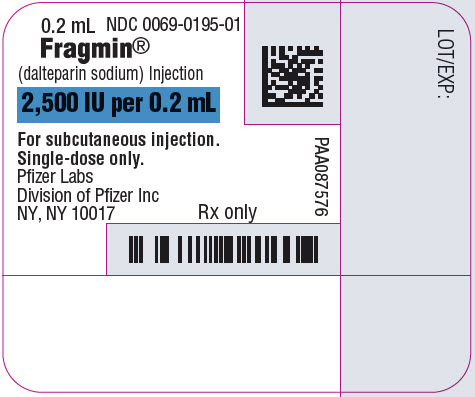
-
PRINCIPAL DISPLAY PANEL - 0.2 mL Syringe Blister Pack Label - 0195
Store at 20°C to 25°C (68°F to 77°F); excursion
permitted between 15°C to 30°C (59°F to 86°F)
[see USP Controlled Room Temperature].
DOSAGE AND USE: See accompanying
prescribing information.
Distributed by Pfizer Labs Division of Pfizer Inc
New York, NY 100170.2 mL Single-dose prefilled syringe
NDC: 0069-0195-01Fragmin® (dalteparin sodium) Injection
2,500 IU per 0.2 mL
For subcutaneous injection.
PAA087583
Rx only
To Open Pull Tab

-
PRINCIPAL DISPLAY PANEL - 0.2 mL Syringe Carton - 0195
NDC: 0069-0195-02
Contains 10 of NDC: 0069-0195-0110 x 0.2 mL Single-dose prefilled syringes,
preassembled with needle guardsFragmin®
(dalteparin sodium) Injection2,500 IU per 0.2 mL*
For subcutaneous injection
SterilePfizer Injectables
Rx only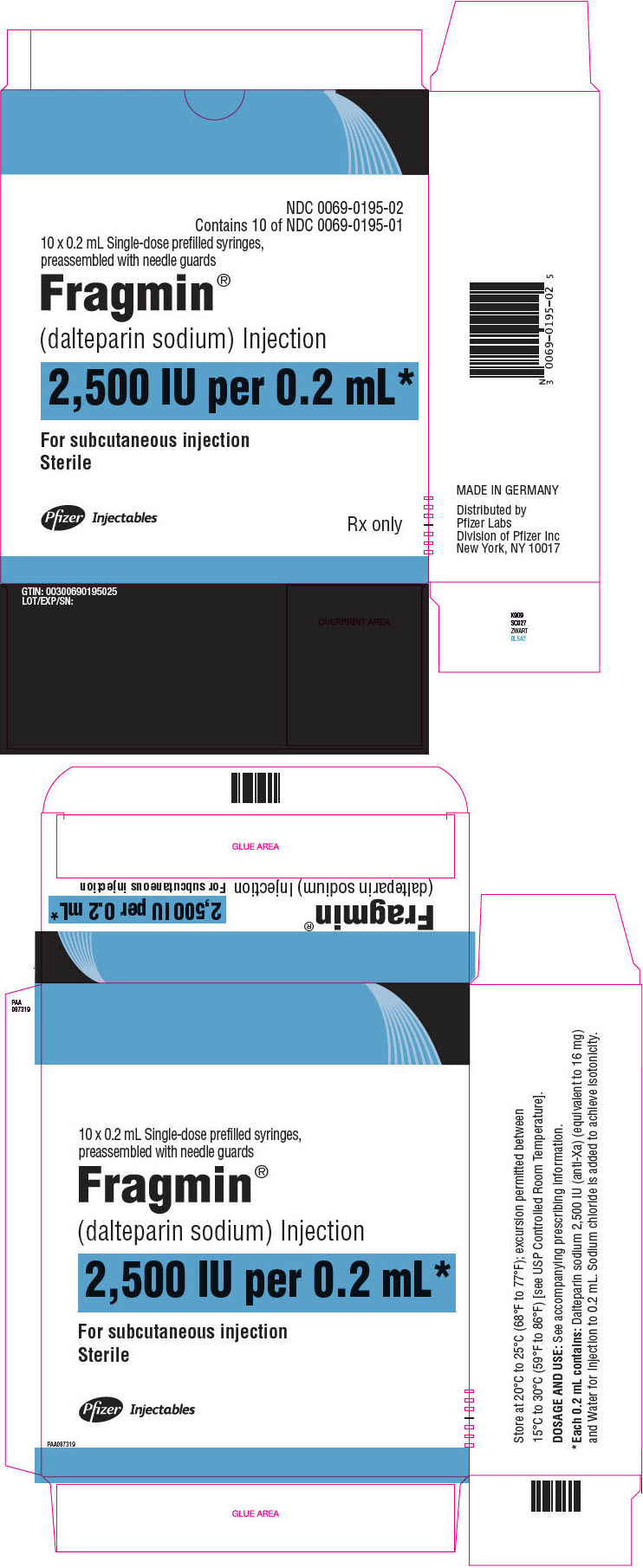
-
PRINCIPAL DISPLAY PANEL - 0.2 mL Syringe Label - 0196
0.2 mL
NDC: 0069-0196-01Fragmin®
(dalteparin sodium) Injection5,000 IU per 0.2 mL
For subcutaneous injection.
Single-dose only.Pfizer Labs
Division of Pfizer Inc
NY, NY 10017Rx only
PAA087577
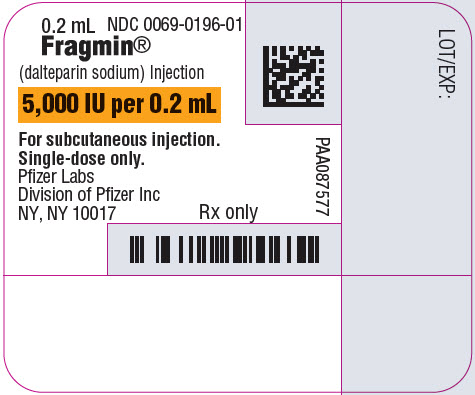
-
PRINCIPAL DISPLAY PANEL - 0.2 mL Syringe Blister Pack Label - 0196
Store at 20°C to 25°C (68°F to 77°F); excursion
permitted between 15°C to 30°C (59°F to 86°F)
[see USP Controlled Room Temperature].
DOSAGE AND USE: See accompanying
prescribing information.
Distributed by Pfizer Labs Division of Pfizer Inc
New York, NY 100170.2 mL Single-dose prefilled syringe
NDC: 0069-0196-01Fragmin® (dalteparin sodium) Injection
5,000 IU per 0.2 mL
For subcutaneous injection.
PAA087584
Rx only
To Open Pull Tab

-
PRINCIPAL DISPLAY PANEL - 0.2 mL Syringe Carton - 0196
NDC: 0069-0196-02
Contains 10 of NDC: 0069-0196-0110 x 0.2 mL Single-dose prefilled syringes,
preassembled with needle guardsFragmin®
(dalteparin sodium) Injection5,000 IU per 0.2 mL*
For subcutaneous injection
SterilePfizer Injectables
Rx only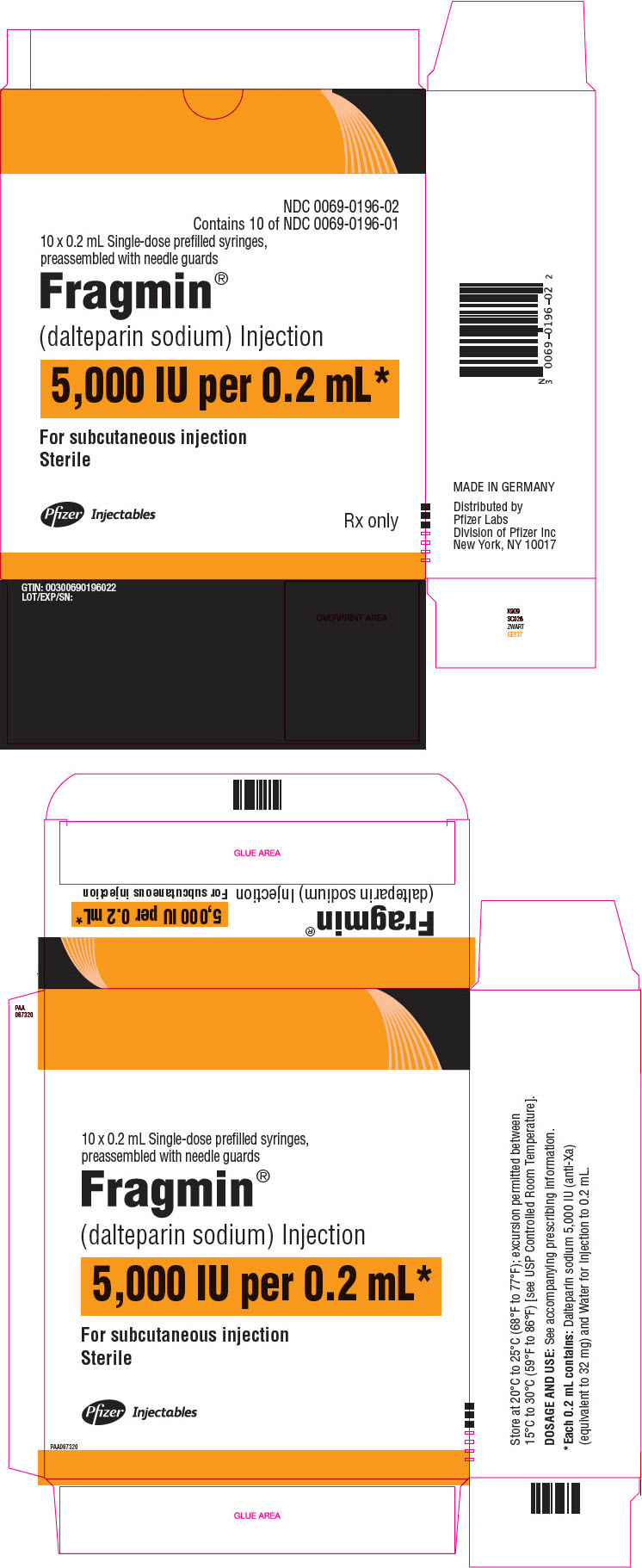
-
PRINCIPAL DISPLAY PANEL - 0.3 mL Syringe Label
0.3 mL
NDC: 0069-0206-01Fragmin®
(dalteparin sodium) Injection7,500 IU per 0.3 mL
For subcutaneous injection.
Single-dose only.Pfizer Labs
Division of Pfizer Inc
NY, NY 10017Rx only
PAA087578
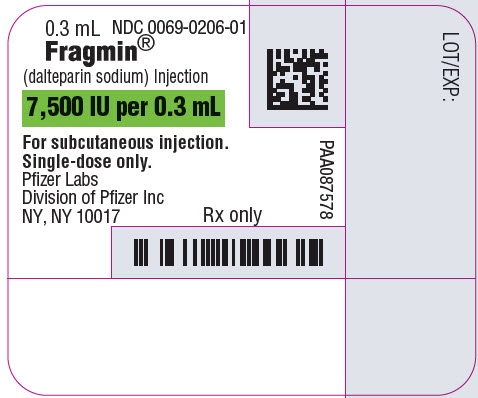
-
PRINCIPAL DISPLAY PANEL - 0.3 mL Syringe Blister Pack Label
Store at 20°C to 25°C (68°F to 77°F); excursion
permitted between 15°C to 30°C (59°F to 86°F)
[see USP Controlled Room Temperature].
DOSAGE AND USE: See accompanying
prescribing information.
Distributed by Pfizer Labs Division of Pfizer Inc
New York, NY 100170.3 mL Single-dose prefilled syringe
NDC: 0069-0206-01Fragmin® (dalteparin sodium) Injection
7,500 IU per 0.3 mL
For subcutaneous injection.
PAA087585
Rx only
To Open Pull Tab

-
PRINCIPAL DISPLAY PANEL - 0.3 mL Syringe Carton
NDC: 0069-0206-02
Contains 10 of NDC: 0069-0206-0110 x 0.3 mL Single-dose prefilled syringes,
preassembled with needle guardsFragmin®
(dalteparin sodium) Injection7,500 IU per 0.3 mL*
For subcutaneous injection
SterilePfizer Injectables
Rx only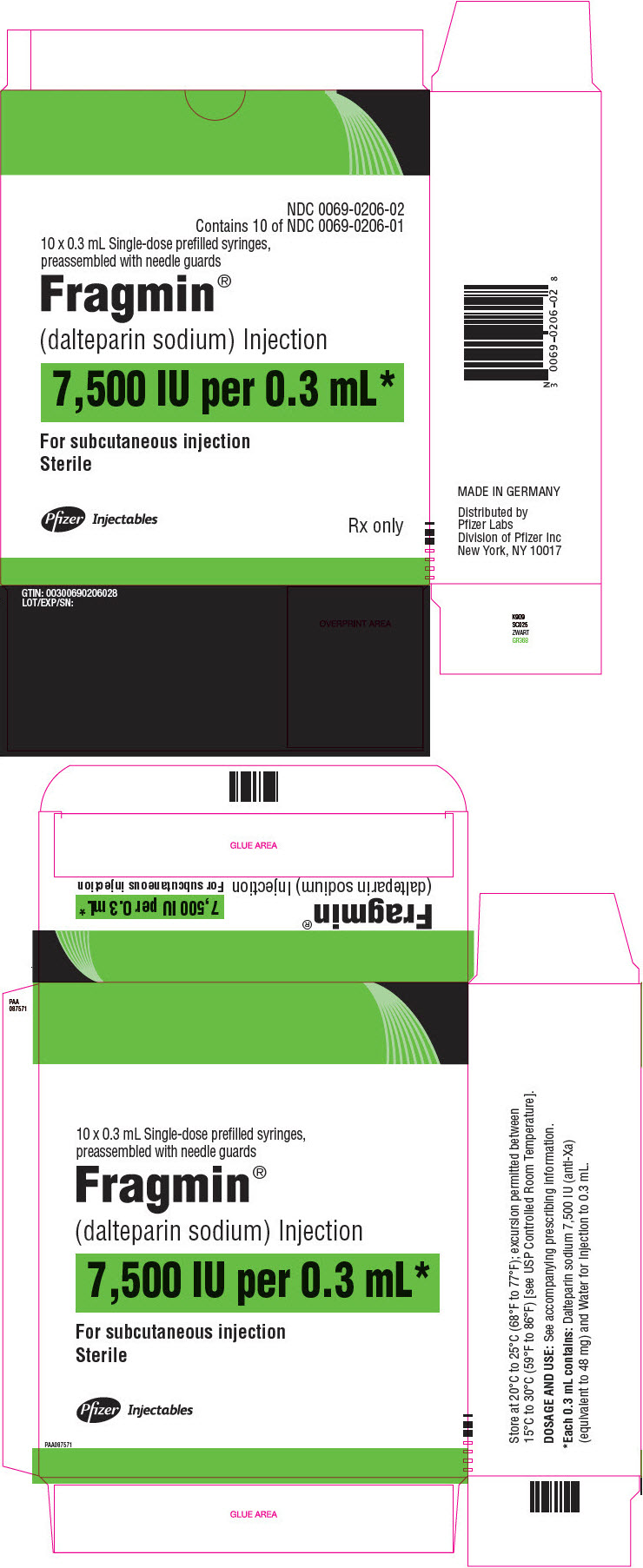
-
PRINCIPAL DISPLAY PANEL - 1 mL Syringe Label
PAA129878
Fragmin®
(dalteparin sodium) Injection
1 mL10,000 IU
per mLFor subcutaneous
injection.
Single-dose only.
Pfizer Labs
Division of Pfizer Inc
NY, NY 10017NDC: 0069-0217-01
Rx only
LOT/EXP:
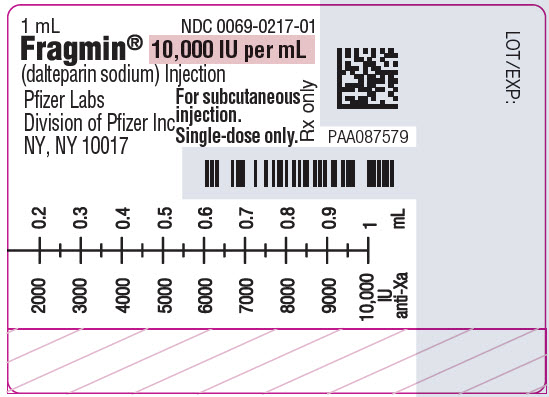
-
PRINCIPAL DISPLAY PANEL - 1 mL Syringe Blister Pack Label
Store at 20°C to 25°C (68°F to 77°F); excursion
permitted between 15°C to 30°C (59°F to 86°F)
[see USP Controlled Room Temperature].
DOSAGE AND USE: See accompanying
prescribing information.
Distributed by Pfizer Labs Division of Pfizer Inc
New York, NY 100171 mL Single-dose graduated syringe
NDC: 0069-0217-01Fragmin® (dalteparin sodium) Injection
10,000 IU per mL
For subcutaneous injection.
PAA087586
Rx only
To Open Pull Tab

-
PRINCIPAL DISPLAY PANEL - 1 mL Syringe Carton
NDC: 0069-0217-02
Contains 10 of NDC: 0069-0217-0110 x 1 mL Single-dose graduated syringes,
preassembled with needle guardsFragmin®
(dalteparin sodium) Injection10,000 IU per mL*
For subcutaneous injection
SterilePfizer Injectables
Rx only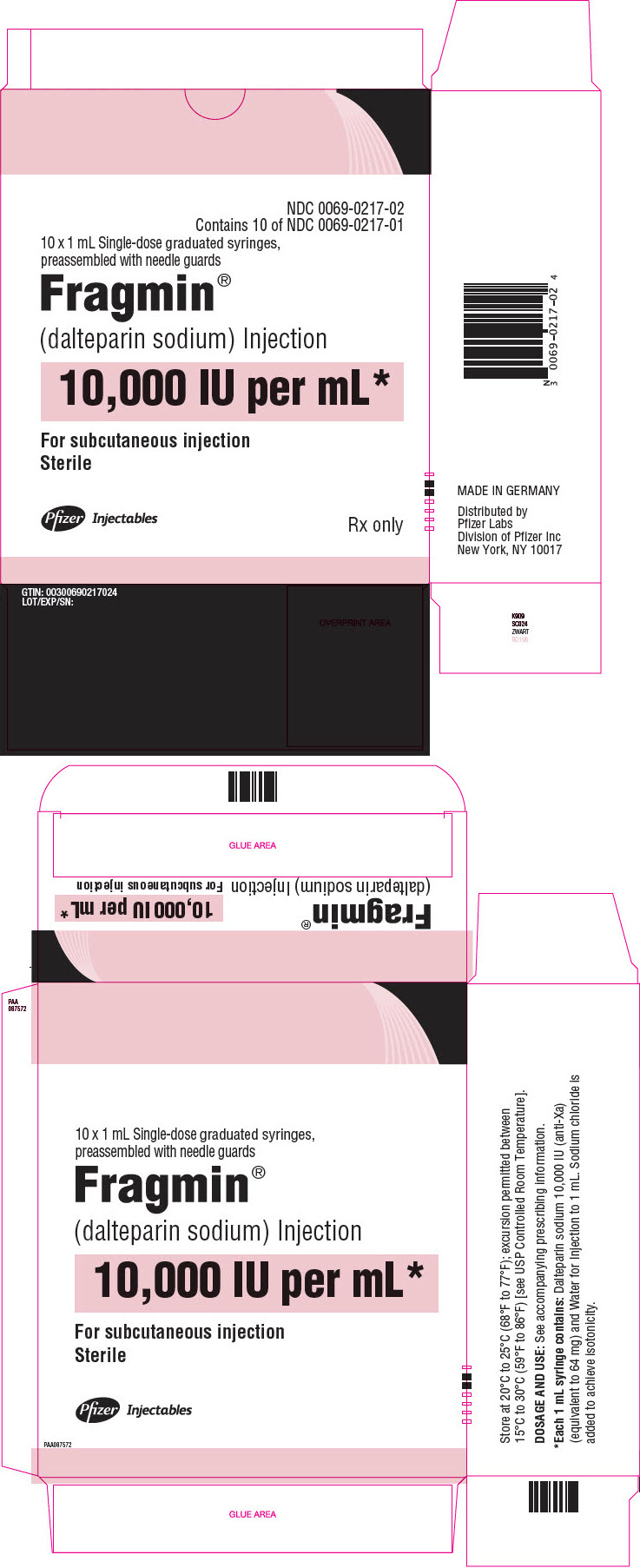
-
PRINCIPAL DISPLAY PANEL - 0.5 mL Syringe Label
0.5 mL NDC: 0069-0220-01
Fragmin®
(dalteparin sodium) Injection12,500 IU per 0.5 mL
For subcutaneous injection.
Single-dose only.Pfizer Labs
Division of Pfizer Inc
NY, NY 10017Rx only
PAA087580
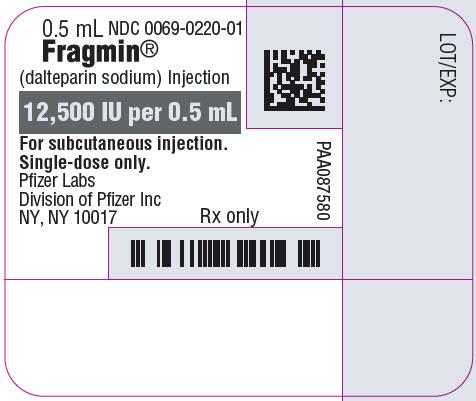
-
PRINCIPAL DISPLAY PANEL - 0.5 mL Syringe Blister Pack Label
Store at 20°C to 25°C (68°F to 77°F); excursion
permitted between 15°C to 30°C (59°F to 86°F)
[see USP Controlled Room Temperature].
DOSAGE AND USE: See accompanying
prescribing information.
Distributed by Pfizer Labs Division of Pfizer Inc
New York, NY 100170.5 mL Single-dose prefilled syringe
NDC: 0069-0220-01Fragmin® (dalteparin sodium) Injection
12,500 IU per 0.5 mL
For subcutaneous injection.
PAA087587
Rx only
To Open Pull Tab

-
PRINCIPAL DISPLAY PANEL - 0.5 mL Syringe Carton
NDC: 0069-0220-02
Contains 10 of NDC: 0069-0220-0110 x 0.5 mL Single-dose prefilled syringes,
preassembled with needle guardsFragmin®
(dalteparin sodium) Injection12,500 IU per 0.5 mL*
For subcutaneous injection
SterilePfizer Injectables
Rx only
-
PRINCIPAL DISPLAY PANEL - 0.6 mL Syringe Label
0.6 mL NDC: 0069-0223-01
Fragmin®
(dalteparin sodium) Injection15,000 IU per 0.6 mL
For subcutaneous injection.
Single-dose only.Pfizer Labs
Division of Pfizer Inc
NY, NY 10017Rx only
PAA087581
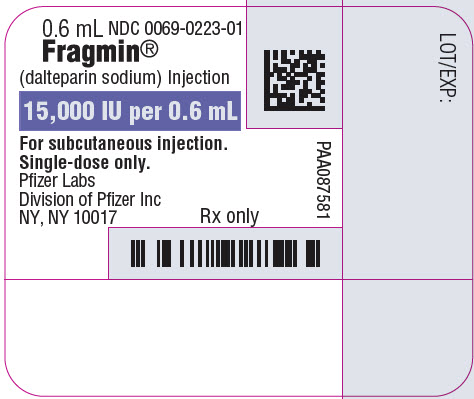
-
PRINCIPAL DISPLAY PANEL - 0.6 mL Syringe Blister Pack Label
Store at 20°C to 25°C (68°F to 77°F); excursion
permitted between 15°C to 30°C (59°F to 86°F)
[see USP Controlled Room Temperature].
DOSAGE AND USE: See accompanying
prescribing information.
Distributed by Pfizer Labs Division of Pfizer Inc
New York, NY 100170.6 mL Single-dose prefilled syringe
NDC: 0069-0223-01Fragmin® (dalteparin sodium) Injection
15,000 IU per 0.6 mL
For subcutaneous injection.
PAA087588
Rx only
To Open Pull Tab

-
PRINCIPAL DISPLAY PANEL - 0.6 mL Syringe Carton
NDC: 0069-0223-02
Contains 10 of NDC: 0069-0223-0110 x 0.6 mL Single-dose prefilled syringes,
preassembled with needle guardsFragmin®
(dalteparin sodium) Injection15,000 IU per 0.6 mL*
For subcutaneous injection
SterilePfizer Injectables
Rx only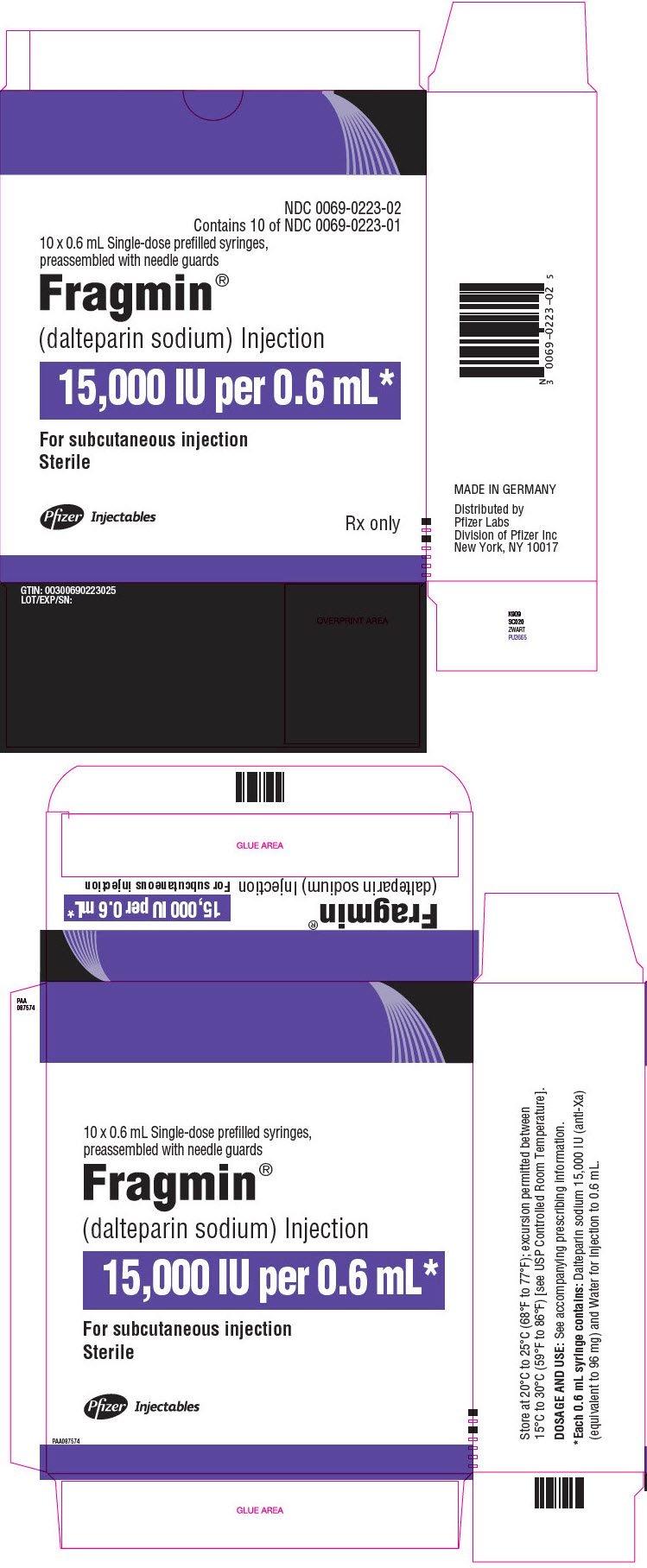
-
PRINCIPAL DISPLAY PANEL - 0.72 mL Syringe Label
0.72 mL
NDC: 0069-0228-01Fragmin®
(dalteparin sodium) Injection18,000 IU per 0.72 mL
For subcutaneous injection.
Single-dose only.Pfizer Labs
Division of Pfizer Inc
NY, NY 10017Rx only
PAA087582
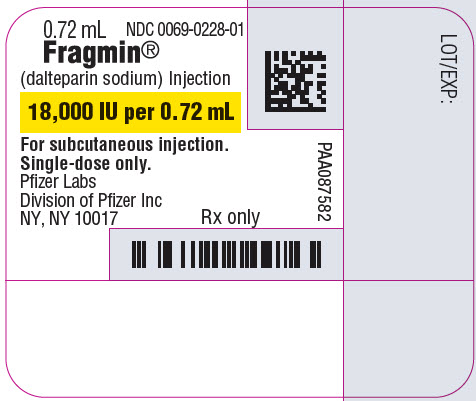
-
PRINCIPAL DISPLAY PANEL - 0.72 mL Syringe Blister Pack Label
Store at 20°C to 25°C (68°to 77°F); excursion
permitted between 15°C to 30°C (59°F to 86°F)
[see USP Controlled Room Temperature].
DOSAGE AND USE: See accompanying prescribing
information.
Distributed by Pfizer Labs Division of Pfizer Inc
New York, NY 100170.72 mL Single-dose prefilled syringe
NDC: 0069-0228-01Fragmin® (dalteparin sodium) Injection
18,000 IU per 0.72 mL
For subcutaneous injection.
PAA087589
Rx only
To Open Pull Tab

-
PRINCIPAL DISPLAY PANEL - 0.72 mL Syringe Carton
NDC: 0069-0228-02
Contains 10 of NDC: 0069-0228-0110 x 0.72 mL Single-dose prefilled syringes,
preassembled with needle guardsFragmin®
(dalteparin sodium) Injection18,000 IU per 0.72 mL*
For subcutaneous injection
SterilePfizer Injectables
Rx only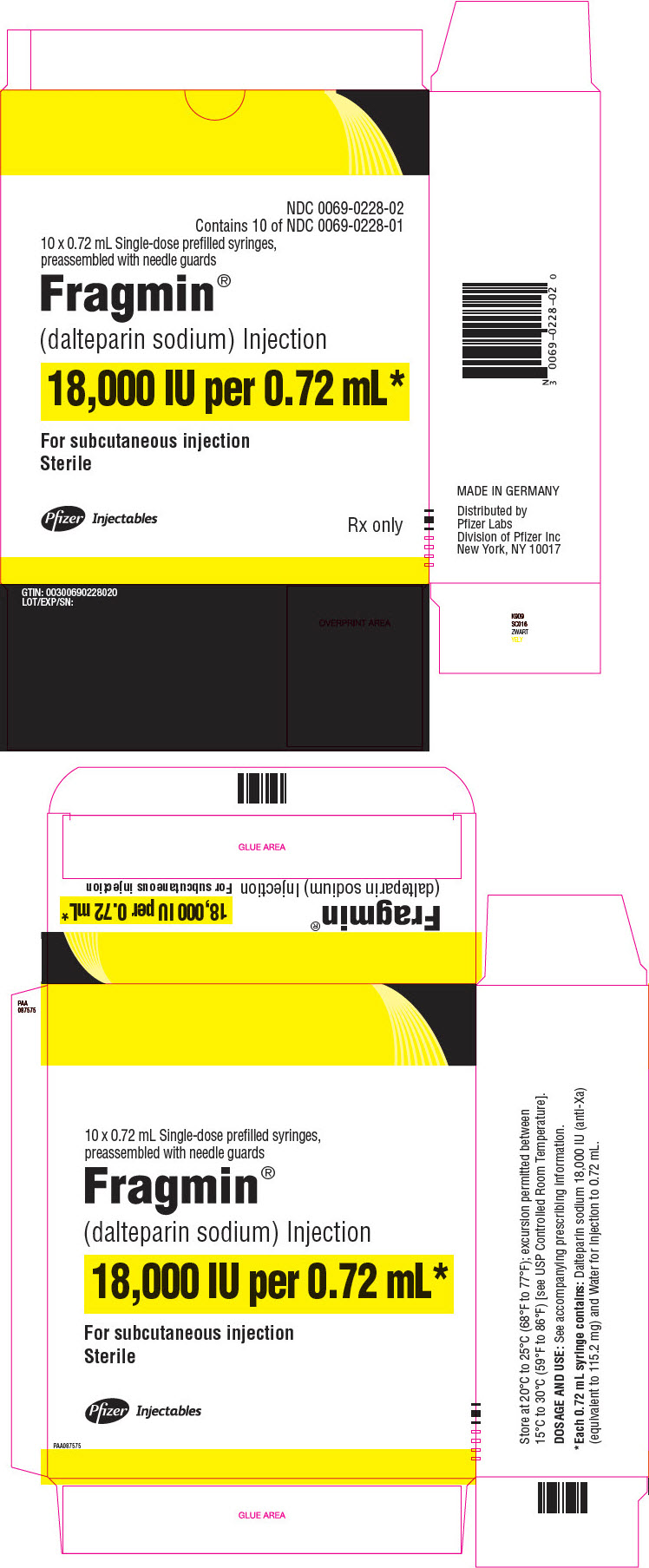
-
PRINCIPAL DISPLAY PANEL - 95,000 IU Vial Label
NDC: 0069-0232-01
3.8 mL multiple-dose vial
Fragmin®
(dalteparin sodium) Injection95,000 IU/3.8 mL
(25,000 IU/mL)For subcutaneous injection
Rx only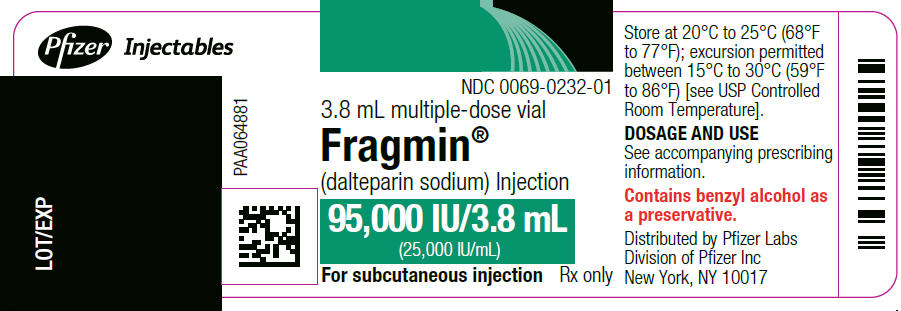
-
PRINCIPAL DISPLAY PANEL - 95,000 IU Vial Carton
NDC: 0069-0232-01
3.8 mL multiple-dose vial
Fragmin®
(dalteparin sodium) Injection95,000 IU/3.8 mL
(25,000 IU/mL)For subcutaneous injection
SterileRx only
Pfizer Injectables

-
INGREDIENTS AND APPEARANCE
FRAGMIN
dalteparin sodium injectionProduct Information Product Type HUMAN PRESCRIPTION DRUG Item Code (Source) NDC: 0069-0195 Route of Administration SUBCUTANEOUS Active Ingredient/Active Moiety Ingredient Name Basis of Strength Strength DALTEPARIN SODIUM (UNII: 12M44VTJ7B) (DALTEPARIN - UNII:S79O08V79F) DALTEPARIN SODIUM 2500 [iU] in 0.2 mL Inactive Ingredients Ingredient Name Strength WATER (UNII: 059QF0KO0R) SODIUM CHLORIDE (UNII: 451W47IQ8X) Packaging # Item Code Package Description Marketing Start Date Marketing End Date 1 NDC: 0069-0195-02 10 in 1 CARTON 04/01/2015 1 NDC: 0069-0195-01 0.2 mL in 1 SYRINGE; Type 2: Prefilled Drug Delivery Device/System (syringe, patch, etc.) Marketing Information Marketing Category Application Number or Monograph Citation Marketing Start Date Marketing End Date NDA NDA020287 04/01/2015 FRAGMIN
dalteparin sodium injectionProduct Information Product Type HUMAN PRESCRIPTION DRUG Item Code (Source) NDC: 0069-0196 Route of Administration SUBCUTANEOUS Active Ingredient/Active Moiety Ingredient Name Basis of Strength Strength DALTEPARIN SODIUM (UNII: 12M44VTJ7B) (DALTEPARIN - UNII:S79O08V79F) DALTEPARIN SODIUM 5000 [iU] in 0.2 mL Inactive Ingredients Ingredient Name Strength WATER (UNII: 059QF0KO0R) SODIUM CHLORIDE (UNII: 451W47IQ8X) Packaging # Item Code Package Description Marketing Start Date Marketing End Date 1 NDC: 0069-0196-02 10 in 1 CARTON 04/01/2015 1 NDC: 0069-0196-01 0.2 mL in 1 SYRINGE; Type 2: Prefilled Drug Delivery Device/System (syringe, patch, etc.) Marketing Information Marketing Category Application Number or Monograph Citation Marketing Start Date Marketing End Date NDA NDA020287 04/01/2015 FRAGMIN
dalteparin sodium injectionProduct Information Product Type HUMAN PRESCRIPTION DRUG Item Code (Source) NDC: 0069-0206 Route of Administration SUBCUTANEOUS Active Ingredient/Active Moiety Ingredient Name Basis of Strength Strength DALTEPARIN SODIUM (UNII: 12M44VTJ7B) (DALTEPARIN - UNII:S79O08V79F) DALTEPARIN SODIUM 7500 [iU] in 0.3 mL Inactive Ingredients Ingredient Name Strength WATER (UNII: 059QF0KO0R) SODIUM CHLORIDE (UNII: 451W47IQ8X) Packaging # Item Code Package Description Marketing Start Date Marketing End Date 1 NDC: 0069-0206-02 10 in 1 CARTON 04/01/2015 1 NDC: 0069-0206-01 0.3 mL in 1 SYRINGE; Type 2: Prefilled Drug Delivery Device/System (syringe, patch, etc.) Marketing Information Marketing Category Application Number or Monograph Citation Marketing Start Date Marketing End Date NDA NDA020287 04/01/2015 FRAGMIN
dalteparin sodium injectionProduct Information Product Type HUMAN PRESCRIPTION DRUG Item Code (Source) NDC: 0069-0217 Route of Administration SUBCUTANEOUS Active Ingredient/Active Moiety Ingredient Name Basis of Strength Strength DALTEPARIN SODIUM (UNII: 12M44VTJ7B) (DALTEPARIN - UNII:S79O08V79F) DALTEPARIN SODIUM 10000 [iU] in 1 mL Inactive Ingredients Ingredient Name Strength WATER (UNII: 059QF0KO0R) SODIUM CHLORIDE (UNII: 451W47IQ8X) Packaging # Item Code Package Description Marketing Start Date Marketing End Date 1 NDC: 0069-0217-02 10 in 1 CARTON 04/01/2015 1 NDC: 0069-0217-01 1 mL in 1 SYRINGE; Type 2: Prefilled Drug Delivery Device/System (syringe, patch, etc.) Marketing Information Marketing Category Application Number or Monograph Citation Marketing Start Date Marketing End Date NDA NDA020287 04/01/2015 FRAGMIN
dalteparin sodium injectionProduct Information Product Type HUMAN PRESCRIPTION DRUG Item Code (Source) NDC: 0069-0220 Route of Administration SUBCUTANEOUS Active Ingredient/Active Moiety Ingredient Name Basis of Strength Strength DALTEPARIN SODIUM (UNII: 12M44VTJ7B) (DALTEPARIN - UNII:S79O08V79F) DALTEPARIN SODIUM 12500 [iU] in 0.5 mL Inactive Ingredients Ingredient Name Strength WATER (UNII: 059QF0KO0R) SODIUM CHLORIDE (UNII: 451W47IQ8X) Packaging # Item Code Package Description Marketing Start Date Marketing End Date 1 NDC: 0069-0220-02 10 in 1 CARTON 04/01/2015 1 NDC: 0069-0220-01 0.5 mL in 1 SYRINGE; Type 2: Prefilled Drug Delivery Device/System (syringe, patch, etc.) Marketing Information Marketing Category Application Number or Monograph Citation Marketing Start Date Marketing End Date NDA NDA020287 04/01/2015 FRAGMIN
dalteparin sodium injectionProduct Information Product Type HUMAN PRESCRIPTION DRUG Item Code (Source) NDC: 0069-0223 Route of Administration SUBCUTANEOUS Active Ingredient/Active Moiety Ingredient Name Basis of Strength Strength DALTEPARIN SODIUM (UNII: 12M44VTJ7B) (DALTEPARIN - UNII:S79O08V79F) DALTEPARIN SODIUM 15000 [iU] in 0.6 mL Inactive Ingredients Ingredient Name Strength WATER (UNII: 059QF0KO0R) SODIUM CHLORIDE (UNII: 451W47IQ8X) Packaging # Item Code Package Description Marketing Start Date Marketing End Date 1 NDC: 0069-0223-02 10 in 1 CARTON 04/01/2015 1 NDC: 0069-0223-01 0.6 mL in 1 SYRINGE; Type 2: Prefilled Drug Delivery Device/System (syringe, patch, etc.) Marketing Information Marketing Category Application Number or Monograph Citation Marketing Start Date Marketing End Date NDA NDA020287 04/01/2015 FRAGMIN
dalteparin sodium injectionProduct Information Product Type HUMAN PRESCRIPTION DRUG Item Code (Source) NDC: 0069-0228 Route of Administration SUBCUTANEOUS Active Ingredient/Active Moiety Ingredient Name Basis of Strength Strength DALTEPARIN SODIUM (UNII: 12M44VTJ7B) (DALTEPARIN - UNII:S79O08V79F) DALTEPARIN SODIUM 18000 [iU] in 0.72 mL Inactive Ingredients Ingredient Name Strength WATER (UNII: 059QF0KO0R) SODIUM CHLORIDE (UNII: 451W47IQ8X) Packaging # Item Code Package Description Marketing Start Date Marketing End Date 1 NDC: 0069-0228-02 10 in 1 CARTON 04/01/2015 1 NDC: 0069-0228-01 0.72 mL in 1 SYRINGE; Type 2: Prefilled Drug Delivery Device/System (syringe, patch, etc.) Marketing Information Marketing Category Application Number or Monograph Citation Marketing Start Date Marketing End Date NDA NDA020287 04/01/2015 FRAGMIN
dalteparin sodium injectionProduct Information Product Type HUMAN PRESCRIPTION DRUG Item Code (Source) NDC: 0069-0232 Route of Administration SUBCUTANEOUS Active Ingredient/Active Moiety Ingredient Name Basis of Strength Strength DALTEPARIN SODIUM (UNII: 12M44VTJ7B) (DALTEPARIN - UNII:S79O08V79F) DALTEPARIN SODIUM 25000 [iU] in 1 mL Inactive Ingredients Ingredient Name Strength WATER (UNII: 059QF0KO0R) BENZYL ALCOHOL (UNII: LKG8494WBH) 14 mg in 1 mL Packaging # Item Code Package Description Marketing Start Date Marketing End Date 1 NDC: 0069-0232-01 1 in 1 CARTON 04/01/2015 1 3.8 mL in 1 VIAL, MULTI-DOSE; Type 0: Not a Combination Product Marketing Information Marketing Category Application Number or Monograph Citation Marketing Start Date Marketing End Date NDA NDA020287 04/01/2015 Labeler - Pfizer Laboratories Div Pfizer Inc (134489525) Establishment Name Address ID/FEI Business Operations Pfizer Manufacturing Belgium NV 370156507 ANALYSIS(0069-0195, 0069-0196, 0069-0206, 0069-0217, 0069-0220, 0069-0223, 0069-0228, 0069-0232) , MANUFACTURE(0069-0232) , PACK(0069-0195, 0069-0196, 0069-0206, 0069-0217, 0069-0220, 0069-0223, 0069-0228, 0069-0232) Establishment Name Address ID/FEI Business Operations Pfizer Health AB 354433591 API MANUFACTURE(0069-0195, 0069-0196, 0069-0206, 0069-0217, 0069-0220, 0069-0223, 0069-0228, 0069-0232)
Trademark Results [Fragmin]
Mark Image Registration | Serial | Company Trademark Application Date |
|---|---|
 FRAGMIN 74589650 2009395 Live/Registered |
PFIZER HEALTH AB 1994-10-24 |
 FRAGMIN 74292024 1973843 Live/Registered |
PFIZER HEALTH AB 1992-07-08 |
 FRAGMIN 73577765 1410088 Dead/Cancelled |
KABIVITRUM AB 1986-01-14 |
© 2026 FDA.report
This site is not affiliated with or endorsed by the FDA.
